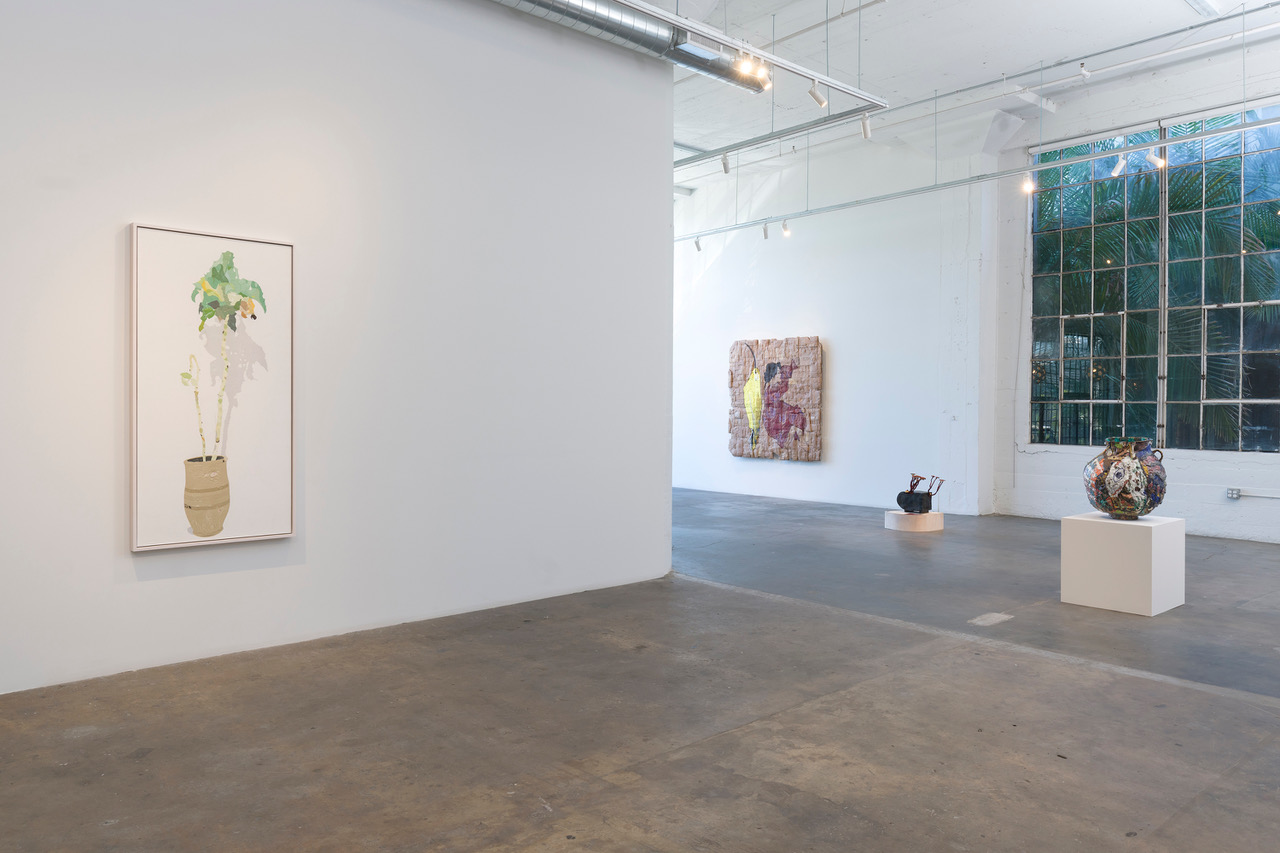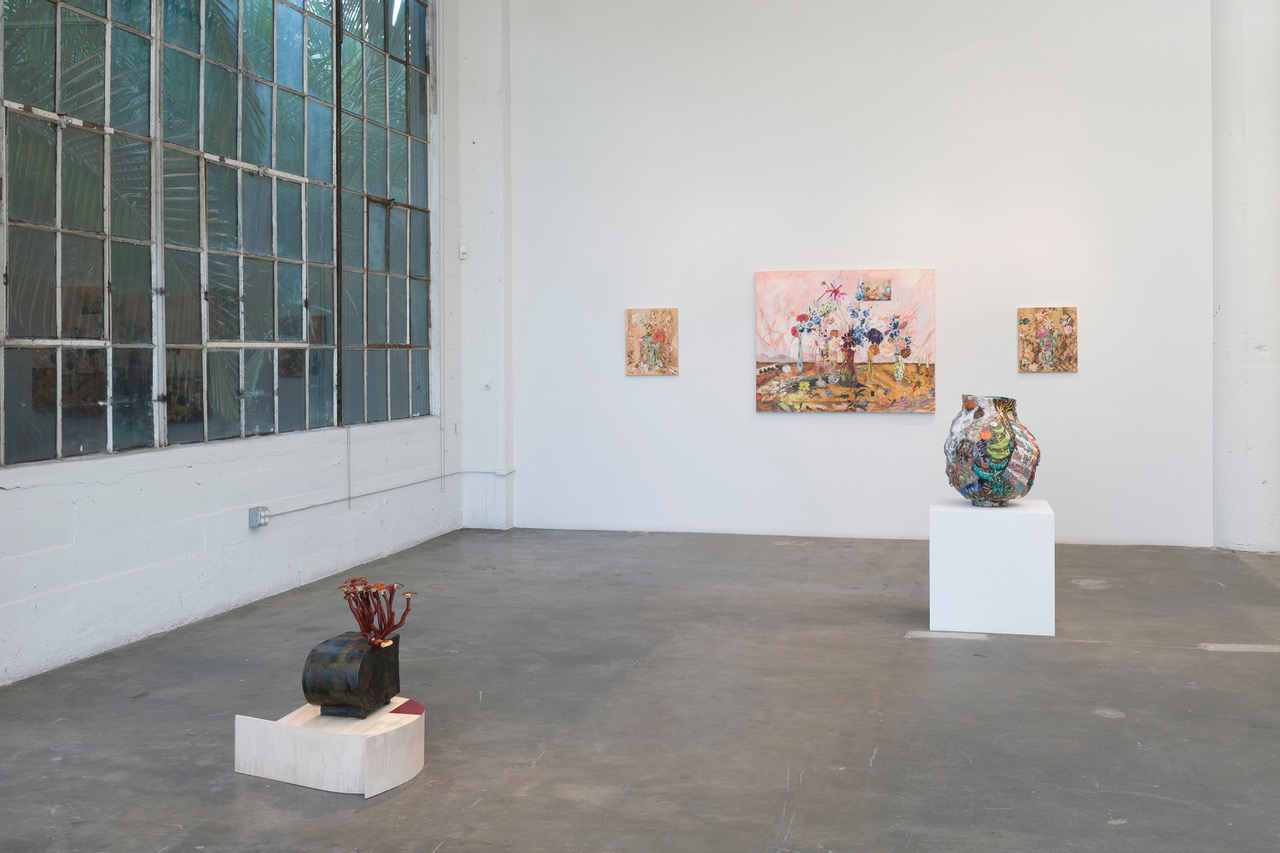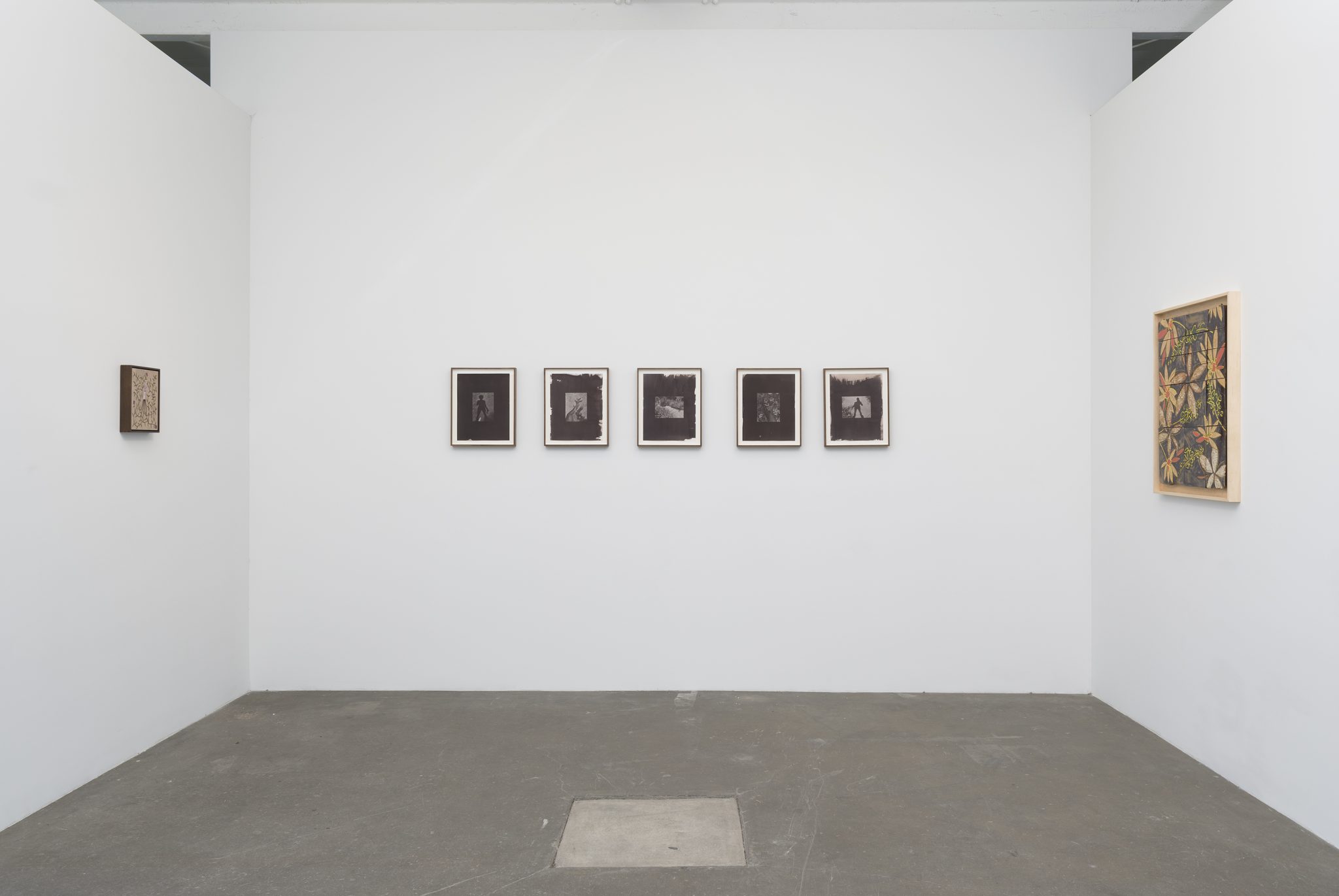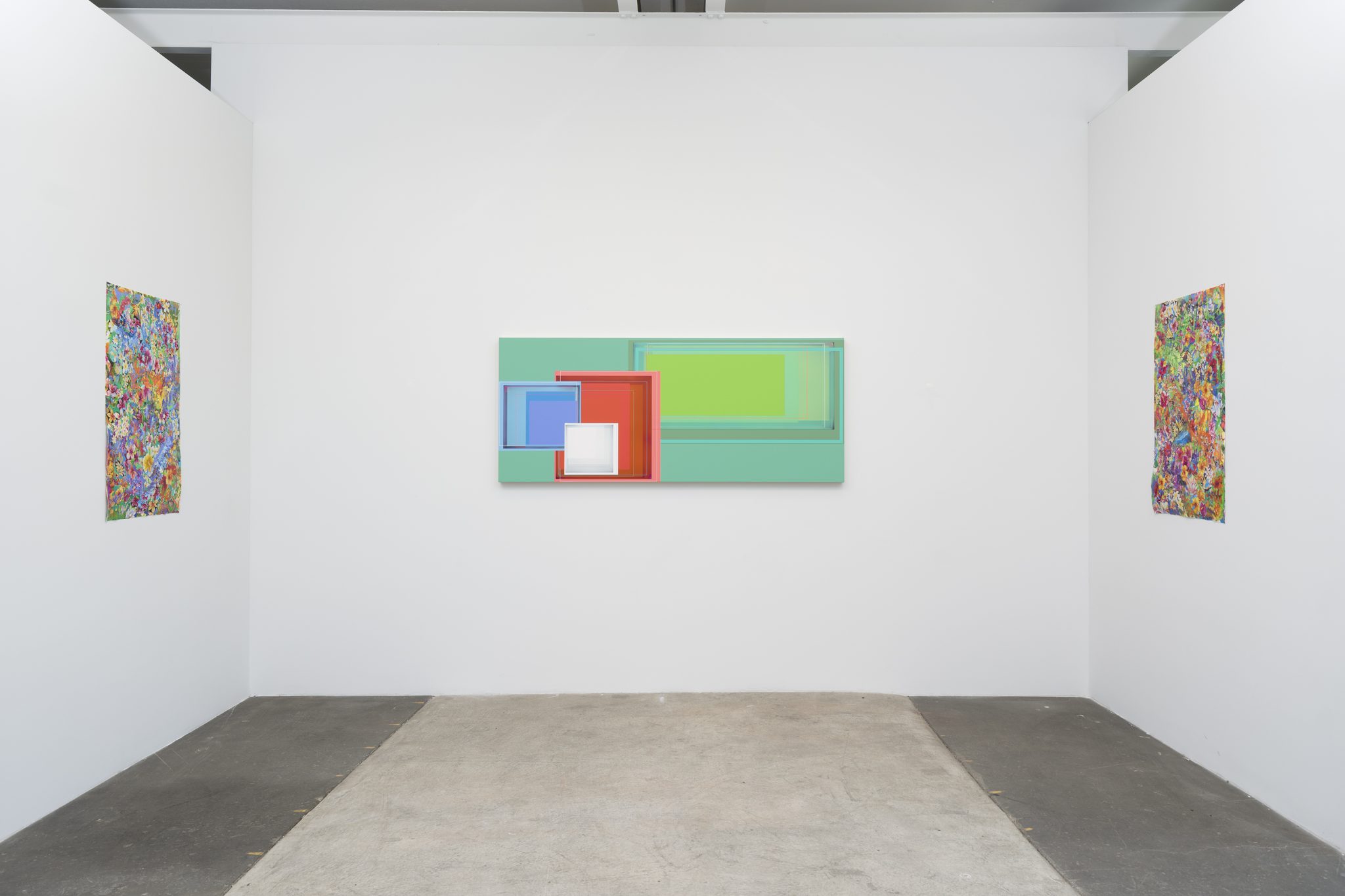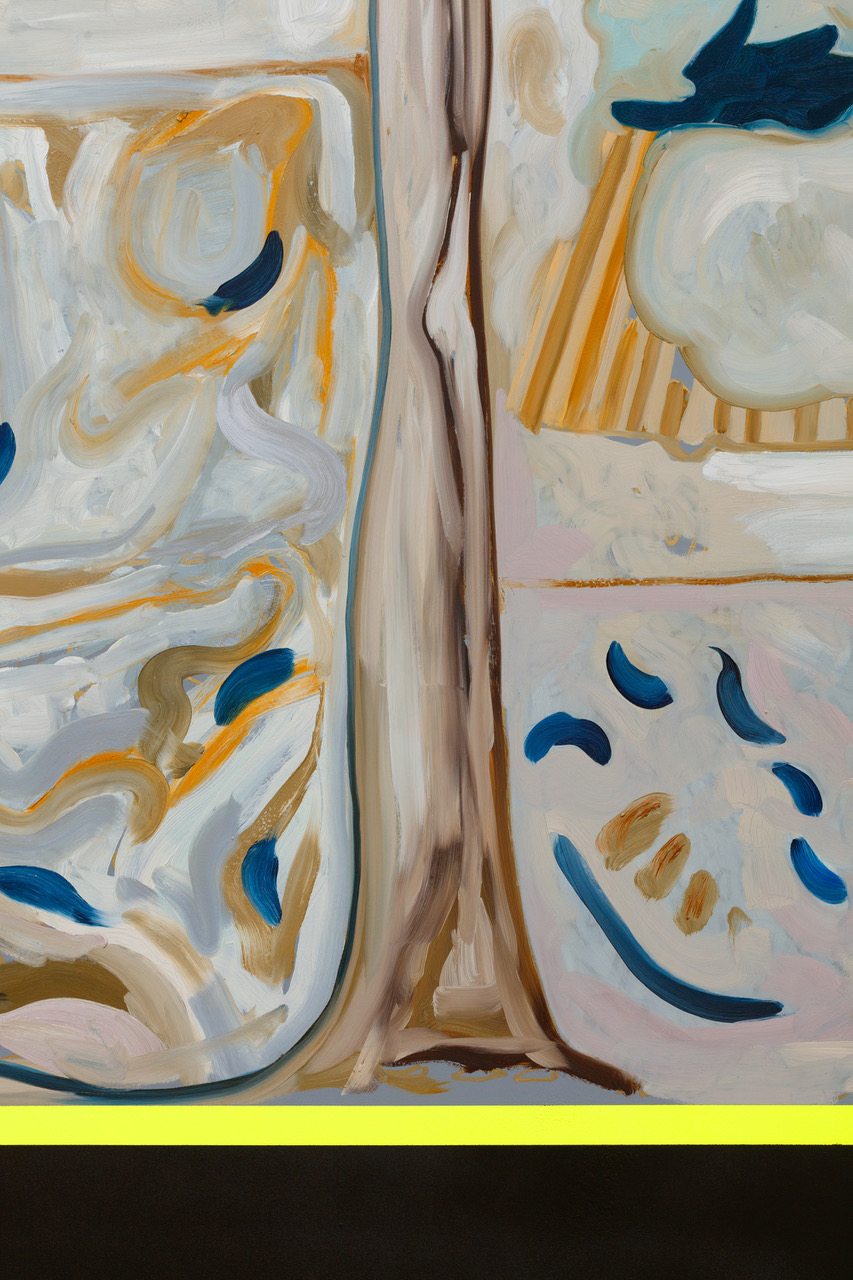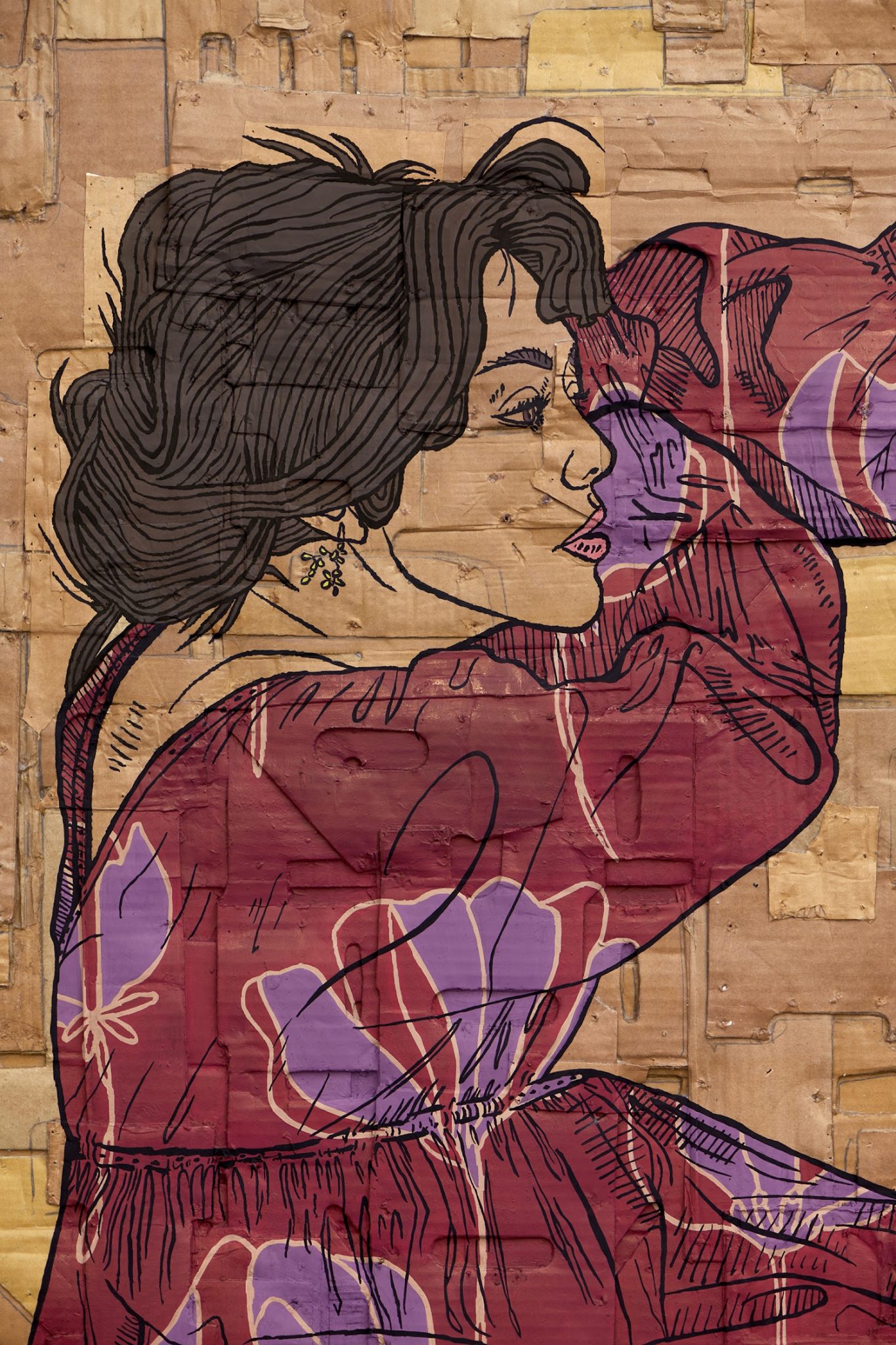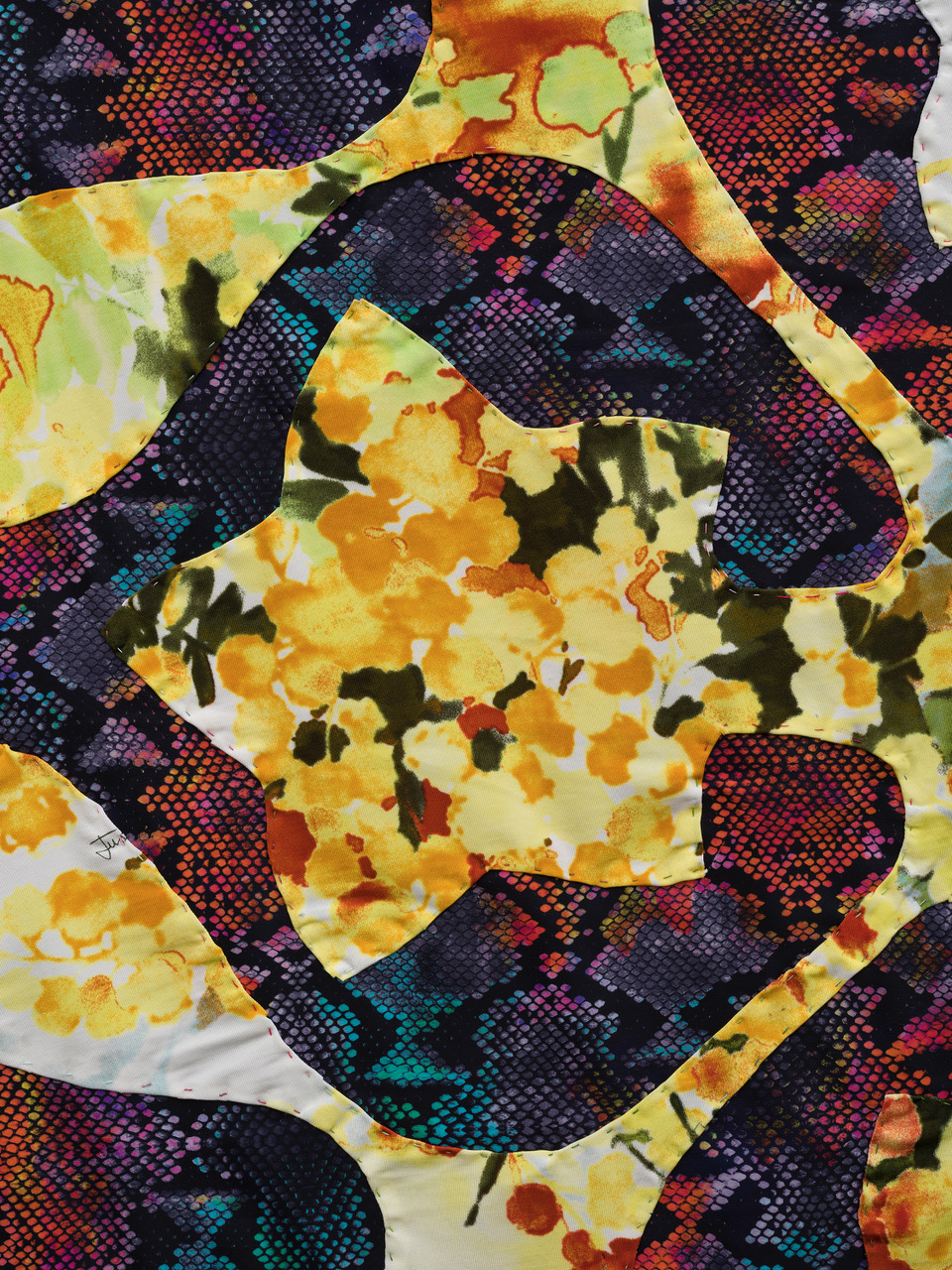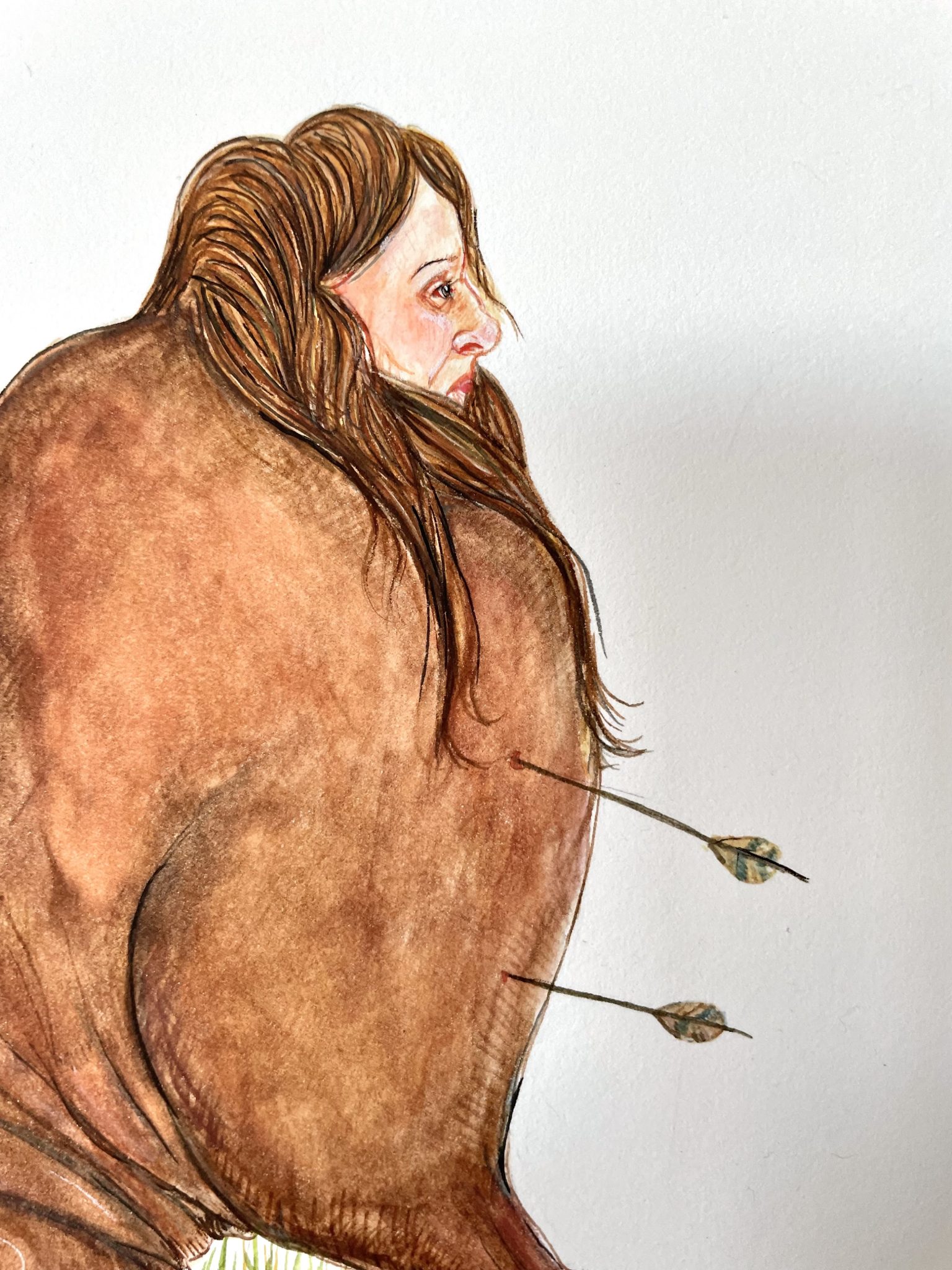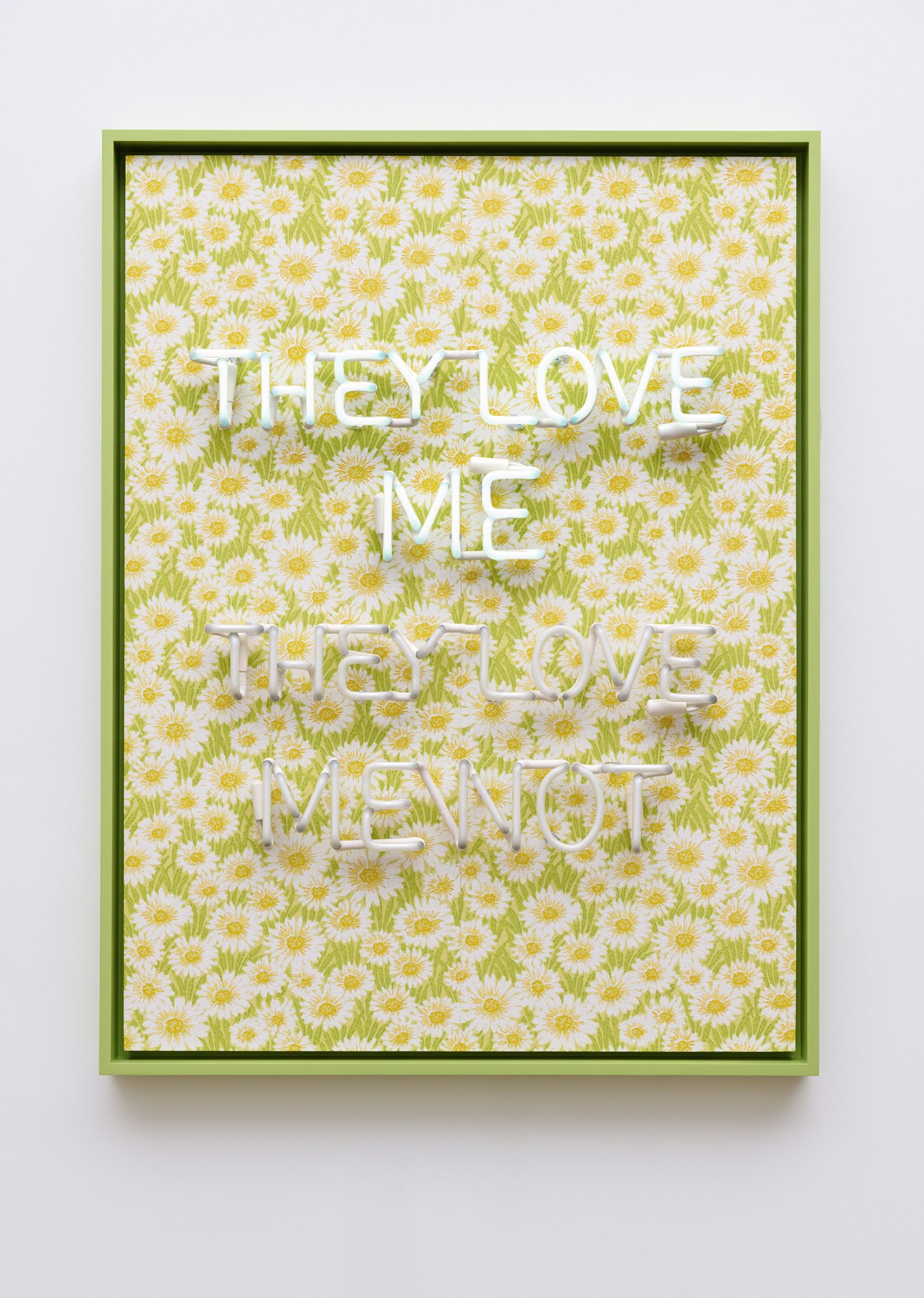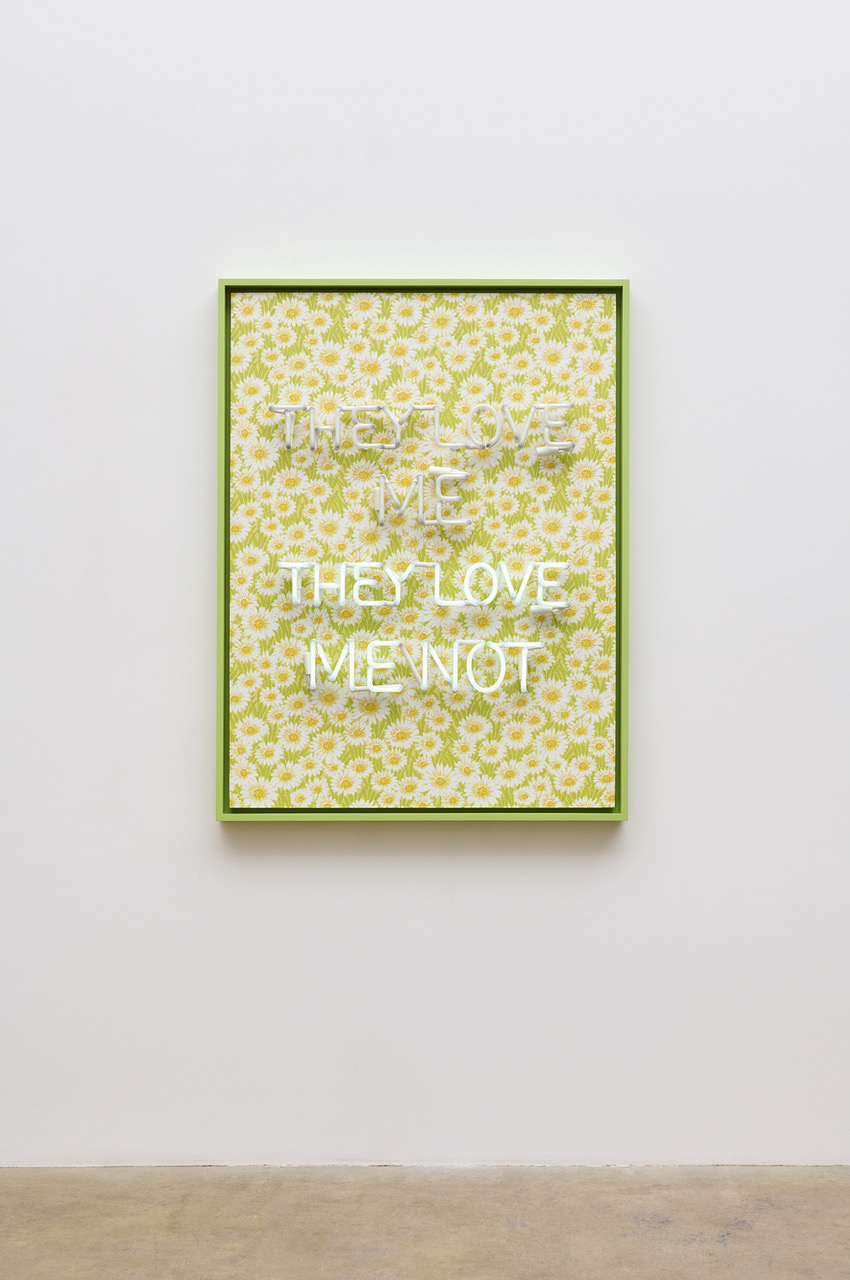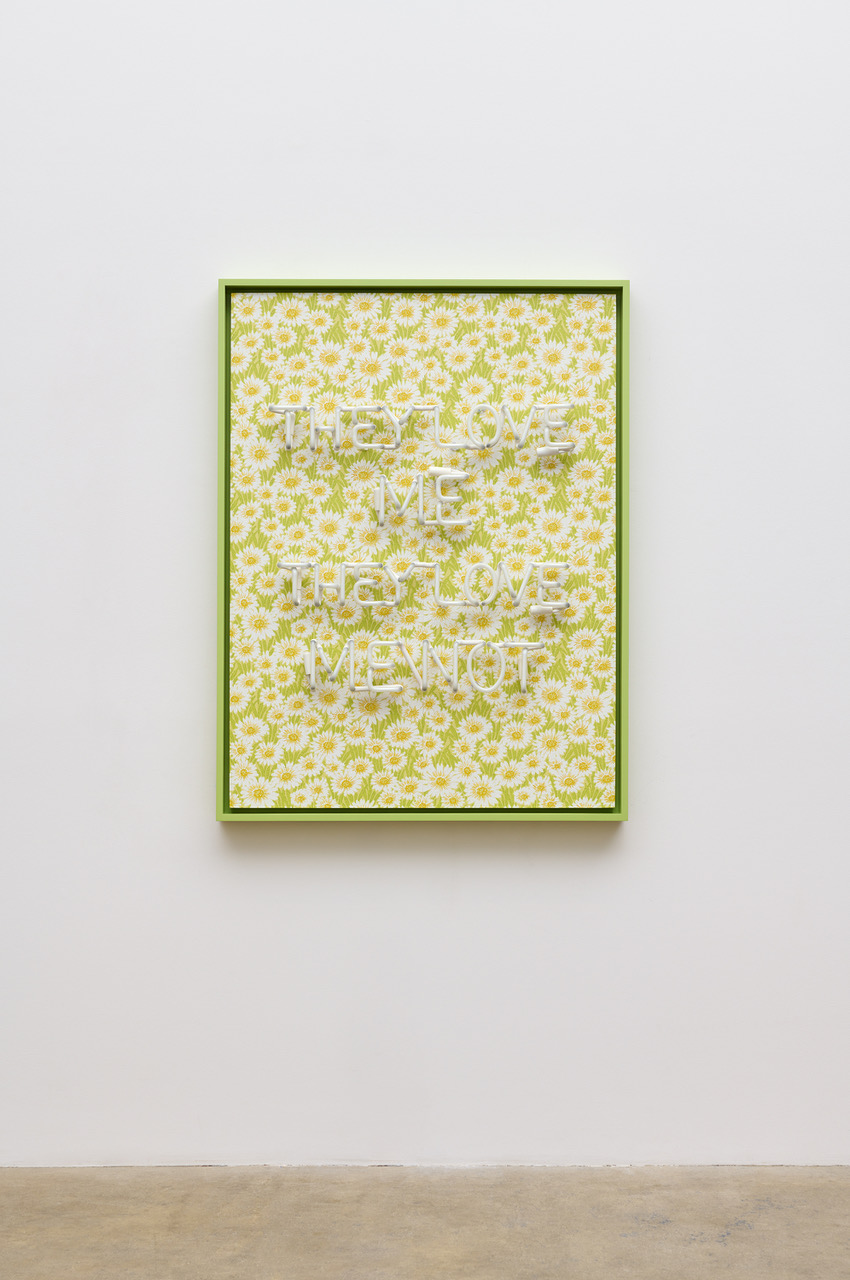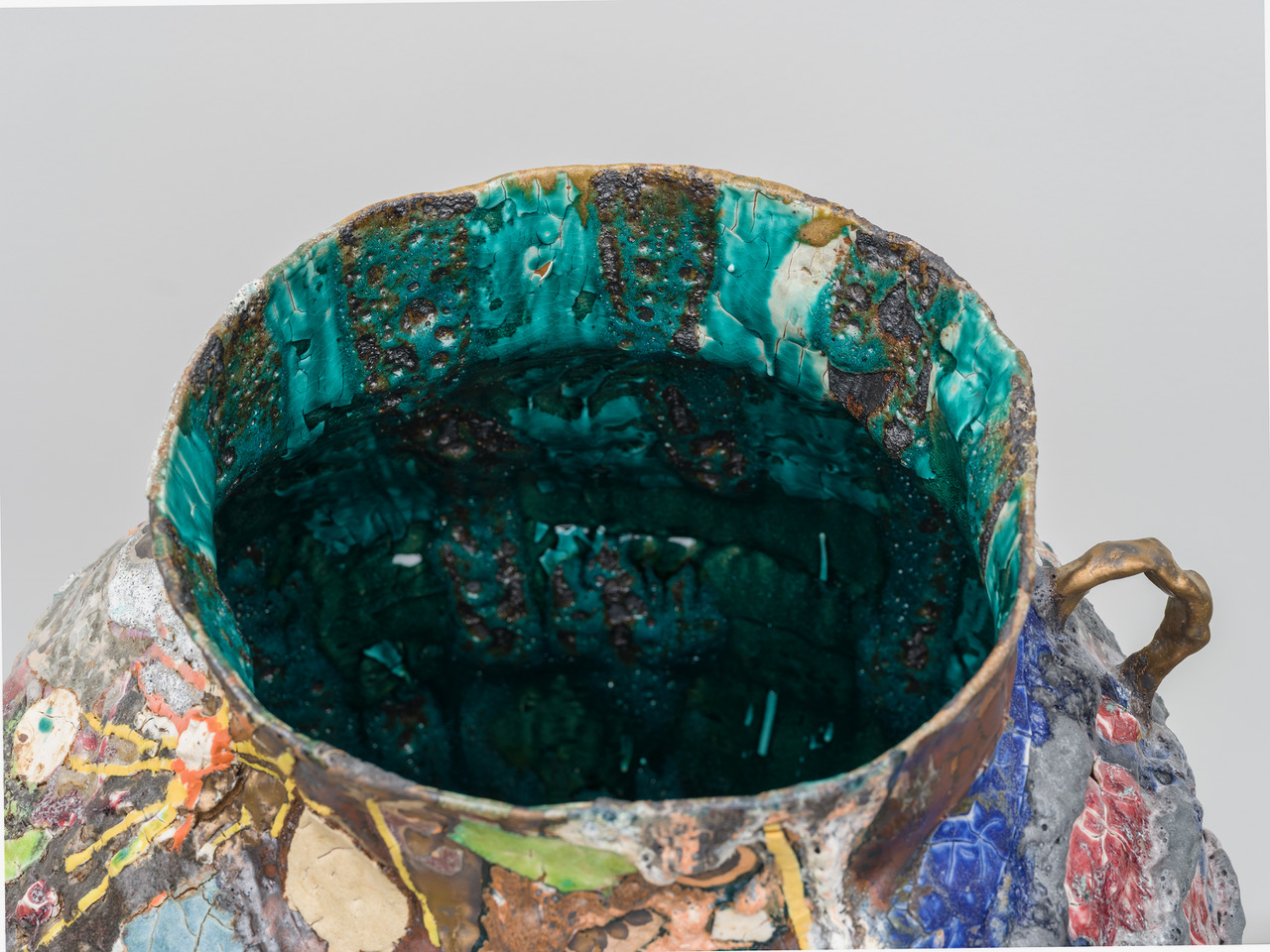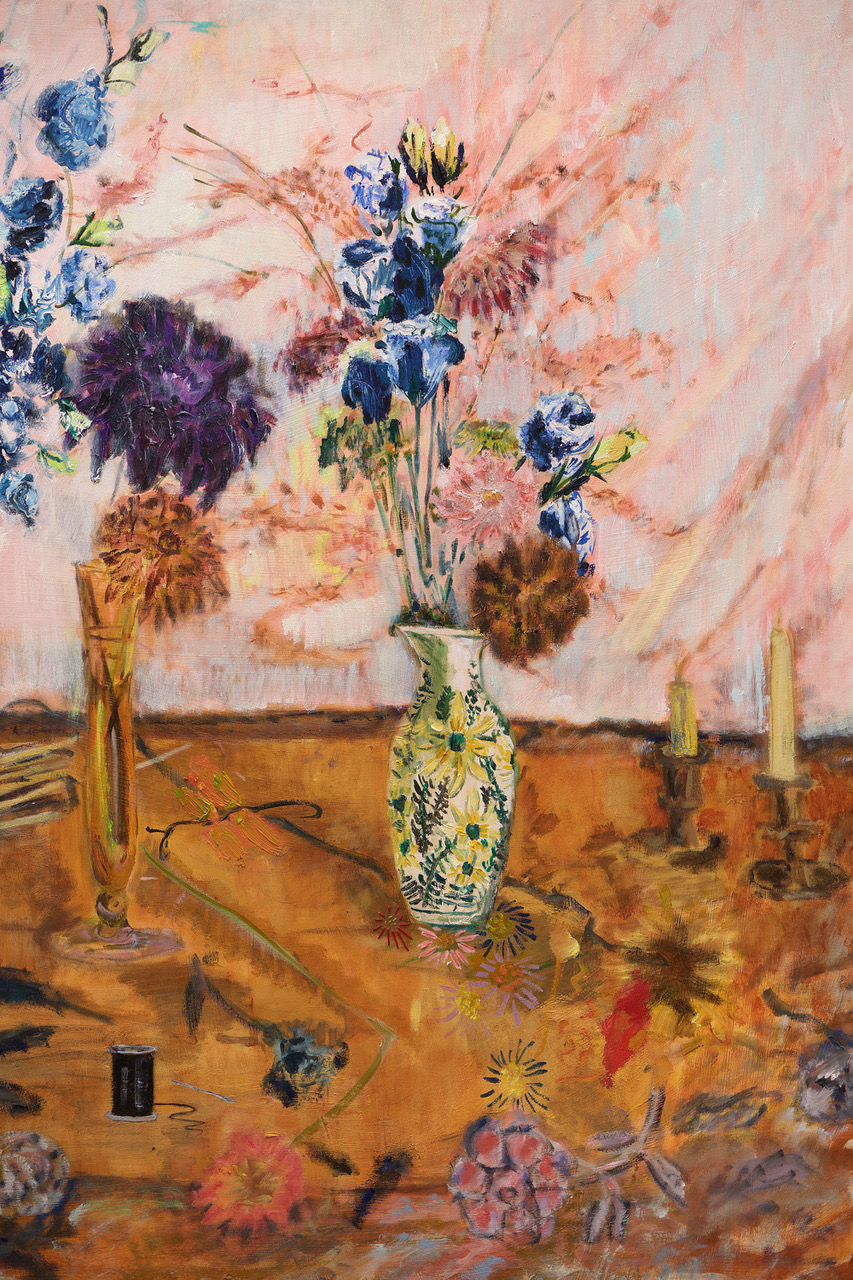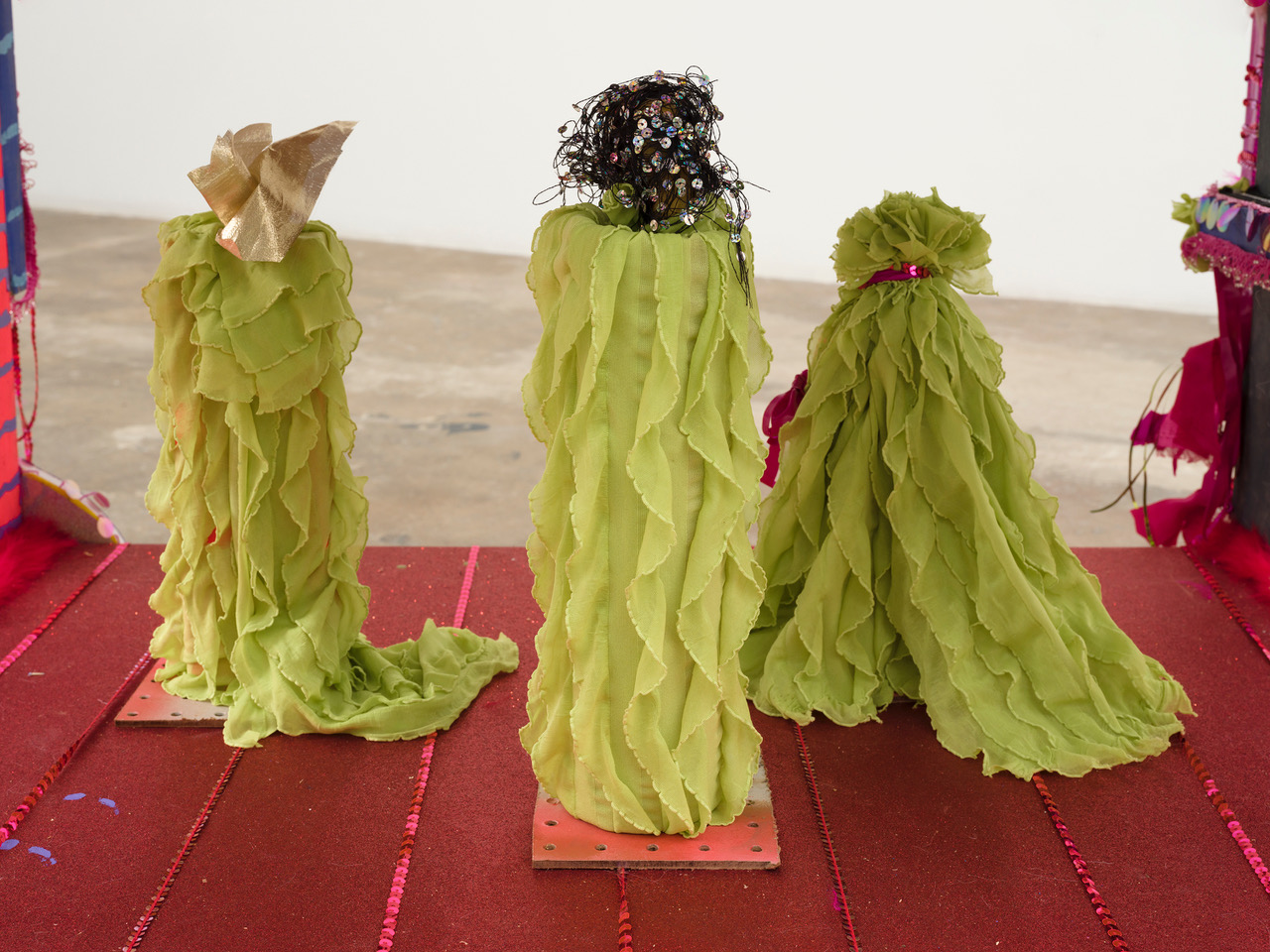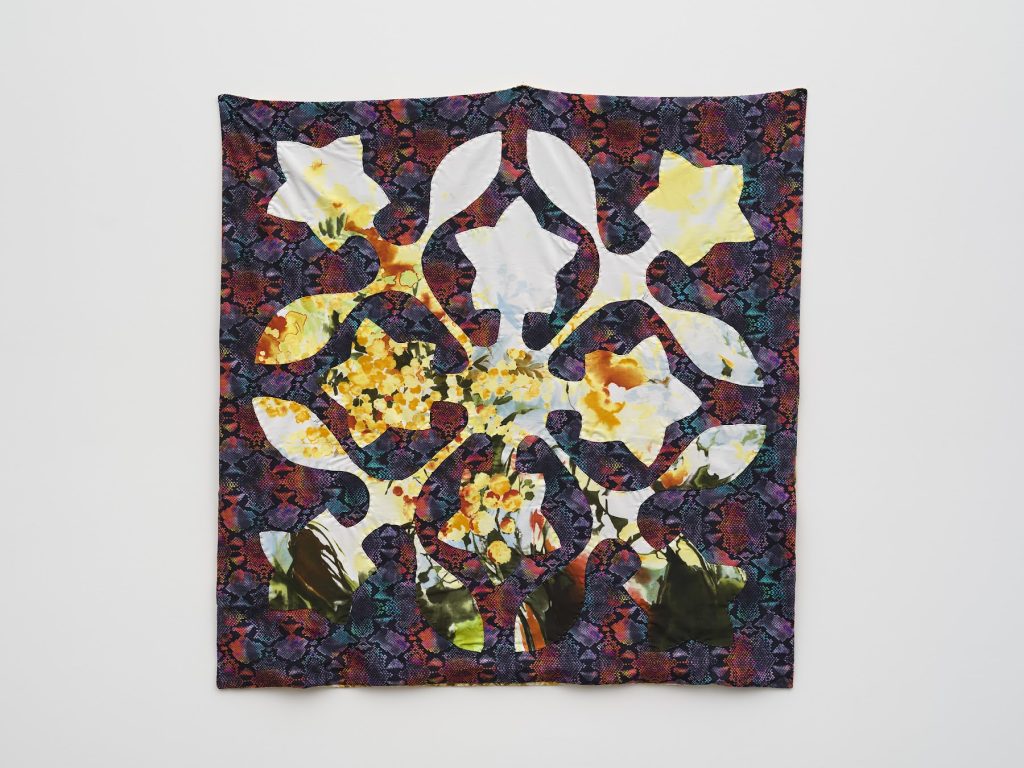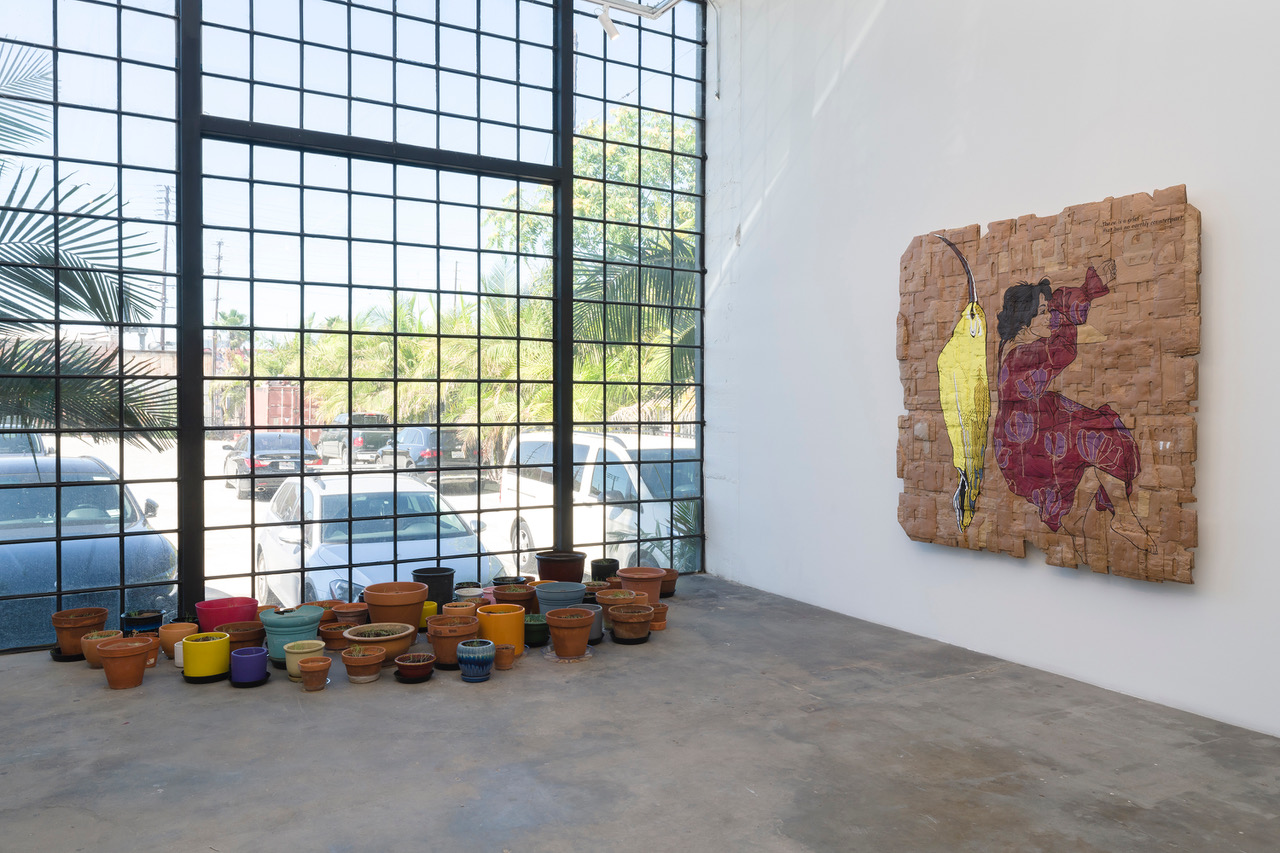

You are currently viewing a placeholder content from Default. To access the actual content, click the button below. Please note that doing so will share data with third-party providers.
More InformationGenevieve Gaignard “Roe v Wade: Liberty and Justice for Some,” 2022
“You sometimes have to paint flowers for your mental health, that’s why you’re doing the flower show right?” Kim Dingle, July 2022
Vielmetter Los Angeles is pleased to present “Plants Now!”, a group exhibition that celebrates plants and explores their far-reaching potential to mitigate a wide range of human-made problems. Running from July 16th through August 26th the exhibition takes place across two galleries, including the gallery’s greenhouse space. The exhibition reaches beyond the traditional exhibition format to include works, wares, and information presented by community activists, compost makers, flower arrangers, bee experts, and food growers. Throughout the exhibition, several programs will take place with local specialists across the fields of mycology, urban gardening, native plants, and pollination.
Artists in the exhibition include Edgar Arceneaux, Felipe Baeza, Math Bass, Darcy Bartoletti, Whitney Bedford, Sadie Benning, Ellen Berkenblit, Andrea Bowers, Alika Cooper, Amy Cutler, Kim Dingle, Genevieve Gaignard, Nash Glynn, David Horvitz, Raffi Kalenderian, Jenny Kendler, Joan Linder, Cassandra Marketos, Hugo McCloud, Rodney McMillian, Paul Mpagi Sepuya, Sam Shoemaker, Jessica Stoller, Nicola Tyson, Tam Van Tran, Ariane Vielmetter, Shanna Waddell, Esther Pearl Watson & Mark Todd, Patrick Wilson, and Bari Ziperstein.
Edgar Arceneaux offers new works from his recent (and ongoing) series entitled Skinning the Mirror — wildly colorful, process-based material abstractions on canvas derived from deconstructed mirrors which include California weeds. These compositions can be seen as fields of gesture and complexity, evoking semblances of the fragility, beauty, and decay typically revealed in our natural world.
“Skinning the Mirror #52,” 2022
Silver nitrate, acrylic paint, glass, California weed on linen
44" x 32" x 1 ³⁄₄" [HxWxD] (111.76 x 81.28 x 4.45 cm)
Inventory #ARC701
Photo credit: Jeff McLane

“Skinning the Mirror #52,” 2022
Silver nitrate, acrylic paint, glass, California weed on linen
44" x 32" x 1 ³⁄₄" [HxWxD] (111.76 x 81.28 x 4.45 cm)
Inventory #ARC701
Photo credit: Jeff McLane
“Skinning the Mirror #52,” 2022
Silver nitrate, acrylic paint, glass, California weed on linen
44" x 32" x 1 ³⁄₄" [HxWxD] (111.76 x 81.28 x 4.45 cm)
Inventory #ARC701
Photo credit: Jeff McLane
“Skinning the Mirror #52,” 2022
Silver nitrate, acrylic paint, glass, California weed on linen
44" x 32" x 1 ³⁄₄" [HxWxD] (111.76 x 81.28 x 4.45 cm)
Inventory #ARC701
Photo credit: Jeff McLane
Felipe Baeza’s work depicts a hand reaching upwards with thorny roots of pink flowers blooming from the floating limb. The leafy veins twist around the composition suggesting a gesture of growth and renewal. The artist describes his use of the figure as “fugitive bodies created over densely layered paintings appear in different states of becoming and at times are even abstracted to the point of invisibility.”
“Después de todo, solo estamos aquí una vez II,” 2022
Ink, watercolor, acrylic, and cut paper collage on panel
10" x 8" [HxW] (25.4 x 20.32 cm); 11" x 9" x 1 ³⁄₄" [HxWxD] (27.94 x 22.86 x 4.44 cm) framed
Inventory #BAE1000
© Felipe Baeza. Courtesy Maureen Paley, London
Photo credit: Brica Wilcox

“Después de todo, solo estamos aquí una vez II,” 2022
Ink, watercolor, acrylic, and cut paper collage on panel
10" x 8" [HxW] (25.4 x 20.32 cm); 11" x 9" x 1 ³⁄₄" [HxWxD] (27.94 x 22.86 x 4.44 cm) framed
Inventory #BAE1000
© Felipe Baeza. Courtesy Maureen Paley, London
Photo credit: Brica Wilcox
Throughout the work of Math Bass, recognizable forms (such as legs, clouds, and flowers) appear, morph, and reappear as shapeshifting signifiers painted in a dreamy, minimal palette. In their overall artistic practice, the artist explores breaking down the common boundaries found within the medium(s) and modes of presentation to actively engage the viewer in both surreal and everyday ways.
“Gemini VI,” 2022
Oil on linen
50" x 52" [HxW] (127 x 132.08 cm)
Inventory #BAS1050
Courtesy of the artist and Vielmetter Los Angeles
Photo credit: Brica Wilcox
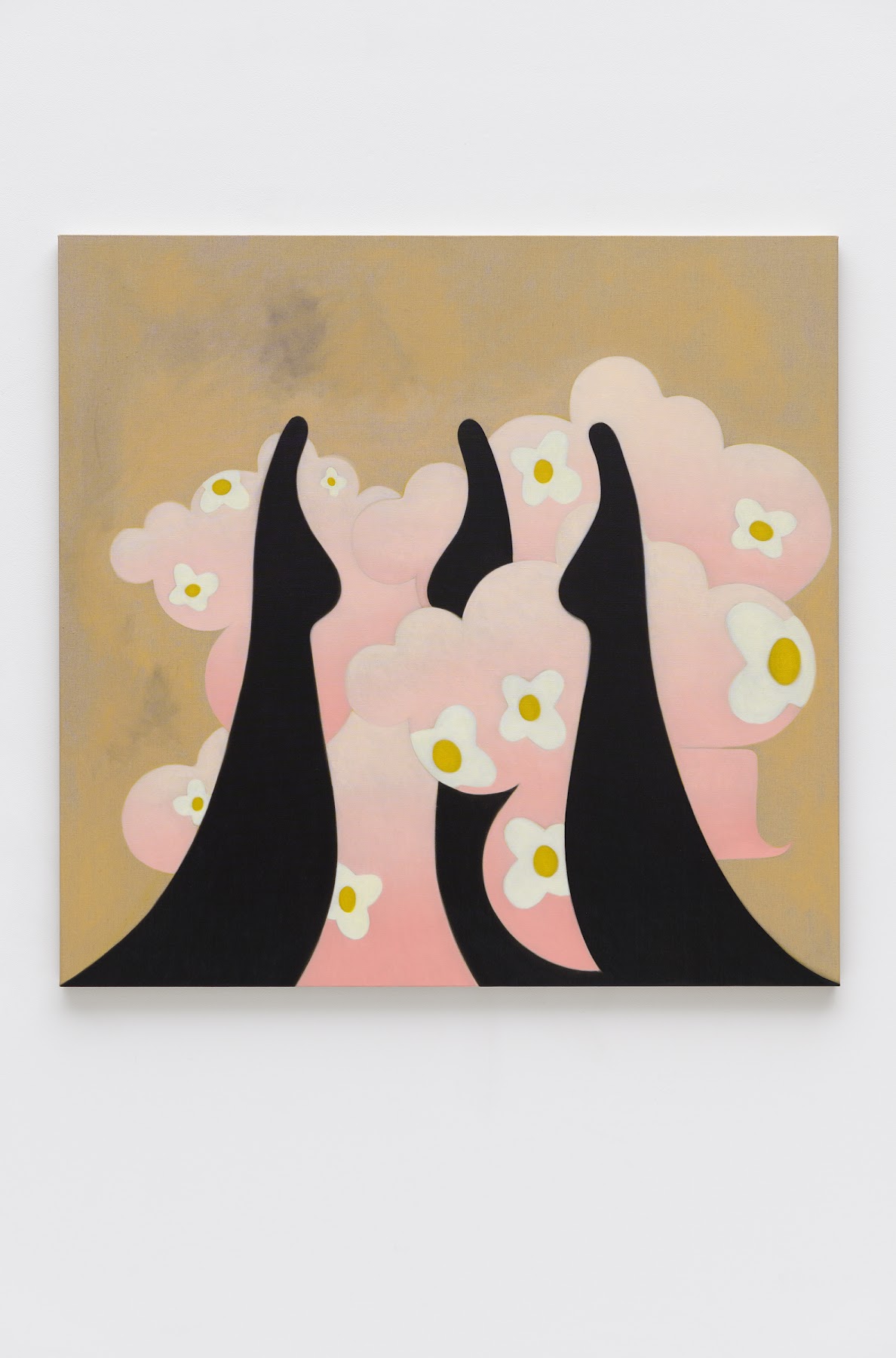
“Gemini VI,” 2022
Oil on linen
50" x 52" [HxW] (127 x 132.08 cm)
Inventory #BAS1050
Courtesy of the artist and Vielmetter Los Angeles
Photo credit: Brica Wilcox
“Gemini VI,” 2022
Oil on linen
50" x 52" [HxW] (127 x 132.08 cm)
Inventory #BAS1050
Courtesy of the artist and Vielmetter Los Angeles
Photo credit: Brica Wilcox
“Gemini VI,” 2022
Oil on linen
50" x 52" [HxW] (127 x 132.08 cm)
Inventory #BAS1050
Courtesy of the artist and Vielmetter Los Angeles
Photo credit: Brica Wilcox
Darcy Bartoletti presents a selection of new works on Japanese Kozo paper. Dense surfaces composed of layers of acrylic paint and fabric flowers appear as intricate windows of inspiration and wild patterning inspired by his life and studio practice in Kauai, Hawaii.
“Rainbow Deluge,” 2022
Acrylic and fabric on Japanese kozo paper
38" x 24 ¹⁄₂" [HxW] (96.52 x 62.23 cm)
Inventory #DAR1000
Courtesy of the artist and Vielmetter Los Angeles
Photo credit: Brica Wilcox

“Rainbow Deluge,” 2022
Acrylic and fabric on Japanese kozo paper
38" x 24 ¹⁄₂" [HxW] (96.52 x 62.23 cm)
Inventory #DAR1000
Courtesy of the artist and Vielmetter Los Angeles
Photo credit: Brica Wilcox
Whitney Bedford’s recent Vedute paintings serve as collectively legible reminders of a time before human exploitation of natural resources shaped a new geological epoch. Translating iconic, historic landscape paintings into her own hand, she also intervenes in their composition, arranging precisely drawn desert plants on stages and behind glass walls in the foreground of each work; sirens from an arid, anxious future.
“Veduta (Bonnard Mediterranean Morning),” 2022
Ink and oil on linen on panel
Triptych: Each panel is 114" x 60" [HxW]; Full Size: 114" x 180" x 9 ¹⁄₂" [HxWxD]
Inventory #BED443
Courtesy of the artist and Vielmetter Los Angeles
Photo credit: Evan Bedford

“Veduta (Bonnard Mediterranean Morning),” 2022
Ink and oil on linen on panel
Triptych: Each panel is 114" x 60" [HxW]; Full Size: 114" x 180" x 9 ¹⁄₂" [HxWxD]
Inventory #BED443
Courtesy of the artist and Vielmetter Los Angeles
Photo credit: Evan Bedford
“Veduta (Bonnard Mediterranean Morning),” 2022
Ink and oil on linen on panel
Triptych: Each panel is 114" x 60" [HxW]; Full Size: 114" x 180" x 9 ¹⁄₂" [HxWxD]
Inventory #BED443
Courtesy of the artist and Vielmetter Los Angeles
Photo credit: Evan Bedford
“Veduta (Bonnard Mediterranean Morning),” 2022
Ink and oil on linen on panel
Triptych: Each panel is 114" x 60" [HxW]; Full Size: 114" x 180" x 9 ¹⁄₂" [HxWxD]
Inventory #BED443
Courtesy of the artist and Vielmetter Los Angeles
Photo credit: Evan Bedford
“Veduta (Bonnard Mediterranean Morning),” 2022
Ink and oil on linen on panel
Triptych: Each panel is 114" x 60" [HxW]; Full Size: 114" x 180" x 9 ¹⁄₂" [HxWxD]
Inventory #BED443
Courtesy of the artist and Vielmetter Los Angeles
Photo credit: Evan Bedford
“Veduta (Bonnard Mediterranean Morning),” 2022
Ink and oil on linen on panel
Triptych: Each panel is 114" x 60" [HxW]; Full Size: 114" x 180" x 9 ¹⁄₂" [HxWxD]
Inventory #BED443
Courtesy of the artist and Vielmetter Los Angeles
Photo credit: Evan Bedford
“Veduta (Bonnard Mediterranean Morning),” 2022
Ink and oil on linen on panel
Triptych: Each panel is 114" x 60" [HxW]; Full Size: 114" x 180" x 9 ¹⁄₂" [HxWxD]
Inventory #BED443
Courtesy of the artist and Vielmetter Los Angeles
Photo credit: Evan Bedford
“Veduta (Bonnard Mediterranean Morning),” 2022
Ink and oil on linen on panel
Triptych: Each panel is 114" x 60" [HxW]; Full Size: 114" x 180" x 9 ¹⁄₂" [HxWxD]
Inventory #BED443
Courtesy of the artist and Vielmetter Los Angeles
Photo credit: Evan Bedford
“Veduta (Bonnard Mediterranean Morning),” 2022
Ink and oil on linen on panel
Triptych: Each panel is 114" x 60" [HxW]; Full Size: 114" x 180" x 9 ¹⁄₂" [HxWxD]
Inventory #BED443
Courtesy of the artist and Vielmetter Los Angeles
Photo credit: Evan Bedford
“Veduta (Bonnard Mediterranean Morning),” 2022
Ink and oil on linen on panel
Triptych: Each panel is 114" x 60" [HxW]; Full Size: 114" x 180" x 9 ¹⁄₂" [HxWxD]
Inventory #BED443
Courtesy of the artist and Vielmetter Los Angeles
Photo credit: Evan Bedford
Sadie Benning’s work on paper is a hand-cut layered work, and similar to their paintings in aqua-resin the composition is derived from a digital image. Juxtaposed with an ink drawing the works represent the relationship between the sun and scorched earth.
“Untitled (flower head),” 2022
Acrylic gouache on paper
10" x 7 ¹⁄₄" [HxW] (25.4 x 18.42 cm)
Inventory #BEN899
Courtesy of the artist and Vielmetter Los Angeles
Photo credit: Brica Wilcox

“Untitled (flower head),” 2022
Acrylic gouache on paper
10" x 7 ¹⁄₄" [HxW] (25.4 x 18.42 cm)
Inventory #BEN899
Courtesy of the artist and Vielmetter Los Angeles
Photo credit: Brica Wilcox
Painted in gouache, a very delicate, technical water-soluble paint that yields rich colors with a matte surface, the tension between containment and expansion is written into the material of the paint in Ellen Berkenblit’s recent works on paper. The painting shows a female figure in an elaborate floral or feathered hat, face in profile, her mouth, if visible, stretched open very wide, as if screaming, her eyes equally wide.
“Flowerdelphia,” 2020
Gouache and graphite on Legion Stonehenge paper
33" x 47" x 2" [HxWxD] (83.82 x 119.38 x 5.08 cm) framed
Inventory #BER196
Courtesy of the artist and Vielmetter Los Angeles
Photo credit: Jeff McLane

“Flowerdelphia,” 2020
Gouache and graphite on Legion Stonehenge paper
33" x 47" x 2" [HxWxD] (83.82 x 119.38 x 5.08 cm) framed
Inventory #BER196
Courtesy of the artist and Vielmetter Los Angeles
Photo credit: Jeff McLane
From the Eco Grief Extinction series, Andrea Bowers’s newest work on cardboard “Eco Grief Extinction Series, There is a Grief That Has No Earthly Counterpart,” depicts a bird species that has vanished: the Kauai Akialoa is one of twenty-three species that has been declared extinct in 2021. Shown alongside a woman suspended in repose, the work appeals to the dignity, safety, and rights of both. The accompanying quote is derived from a line of poetry from the healer and poet Deena Metzger.
“Eco Grief Extinction Series, There is a Grief That Has No Earthly Counterpart,” 2022
Acrylic Marker on Cardboard
72" x 72" [HxW] (182.88 x 182.88 cm)
Inventory #BOW612
Courtesy of the artist and Vielmetter Los Angeles
Photo credit: Brica Wilcox

“Eco Grief Extinction Series, There is a Grief That Has No Earthly Counterpart,” 2022
Acrylic Marker on Cardboard
72" x 72" [HxW] (182.88 x 182.88 cm)
Inventory #BOW612
Courtesy of the artist and Vielmetter Los Angeles
Photo credit: Brica Wilcox
“Eco Grief Extinction Series, There is a Grief That Has No Earthly Counterpart,” 2022
Acrylic Marker on Cardboard
72" x 72" [HxW] (182.88 x 182.88 cm)
Inventory #BOW612
Courtesy of the artist and Vielmetter Los Angeles
Photo credit: Brica Wilcox
“Eco Grief Extinction Series, There is a Grief That Has No Earthly Counterpart,” 2022
Acrylic Marker on Cardboard
72" x 72" [HxW] (182.88 x 182.88 cm)
Inventory #BOW612
Courtesy of the artist and Vielmetter Los Angeles
Photo credit: Brica Wilcox
“Eco Grief Extinction Series, There is a Grief That Has No Earthly Counterpart,” 2022
Acrylic Marker on Cardboard
72" x 72" [HxW] (182.88 x 182.88 cm)
Inventory #BOW612
Courtesy of the artist and Vielmetter Los Angeles
Photo credit: Brica Wilcox
“Eco Grief Extinction Series, There is a Grief That Has No Earthly Counterpart,” 2022
Acrylic Marker on Cardboard
72" x 72" [HxW] (182.88 x 182.88 cm)
Inventory #BOW612
Courtesy of the artist and Vielmetter Los Angeles
Photo credit: Brica Wilcox
Alika Cooper’s bronze “Cloche” sculptures are cast from sculptural arrangements of fringe, lace, tassels, and bits of fabric. They form a kind of cage or dome that recalls the bell-shaped glass structures used in Victorian gardening as mini-greenhouses. Cooper’s interest in textiles is a recurring theme in her work. A new quilt piece incorporates designer swimsuit fabrics into an appliqued floral pattern rooted in Hawaiian quilting traditions.
“Sequin,” 2020
Bronze
16 ¹⁄₄" x 14 ¹⁄₂" x 14" [HxWxD] (41.28 x 36.83 x 35.56 cm)
Inventory #COO1000
Courtesy of the artist and Vielmetter Los Angeles
Photo credit: Brica Wilcox

“Sequin,” 2020
Bronze
16 ¹⁄₄" x 14 ¹⁄₂" x 14" [HxWxD] (41.28 x 36.83 x 35.56 cm)
Inventory #COO1000
Courtesy of the artist and Vielmetter Los Angeles
Photo credit: Brica Wilcox
“Sequin,” 2020
Bronze
16 ¹⁄₄" x 14 ¹⁄₂" x 14" [HxWxD] (41.28 x 36.83 x 35.56 cm)
Inventory #COO1000
Courtesy of the artist and Vielmetter Los Angeles
Photo credit: Brica Wilcox
“Sequin,” 2020
Bronze
16 ¹⁄₄" x 14 ¹⁄₂" x 14" [HxWxD] (41.28 x 36.83 x 35.56 cm)
Inventory #COO1000
Courtesy of the artist and Vielmetter Los Angeles
Photo credit: Brica Wilcox
“Sequin,” 2020
Bronze
16 ¹⁄₄" x 14 ¹⁄₂" x 14" [HxWxD] (41.28 x 36.83 x 35.56 cm)
Inventory #COO1000
Courtesy of the artist and Vielmetter Los Angeles
Photo credit: Brica Wilcox
“Summer Python (Plumeria),” 2022
Quilted spandex
52 ¹⁄₂" x 52 ¹⁄₂" [HxW] (133.35 x 133.35 cm)
Inventory #COO1004
Courtesy of the artist and Vielmetter Los Angeles
Photo credit: Jeff McLane

“Summer Python (Plumeria),” 2022
Quilted spandex
52 ¹⁄₂" x 52 ¹⁄₂" [HxW] (133.35 x 133.35 cm)
Inventory #COO1004
Courtesy of the artist and Vielmetter Los Angeles
Photo credit: Jeff McLane
“Summer Python (Plumeria),” 2022
Quilted spandex
52 ¹⁄₂" x 52 ¹⁄₂" [HxW] (133.35 x 133.35 cm)
Inventory #COO1004
Courtesy of the artist and Vielmetter Los Angeles
Photo credit: Jeff McLane
Amy Cutler’s work “Narcissus” is as the artist describes “a revision of the Greek myth of Narcissus.” The gouache painting depicts a hybrid creature, part horse and part woman. As Cutler describes, “The woman exists as part of the horse but her stability and agility are highly compromised. She longs to move forward but is thwarted by arrows and her contorted effort to stand on two legs. The arrows are a nod to the depiction of St. Sebastian; the patron saint of plague and illness, archers, athletes, and dying soldiers. The Narcissus flower or plant lies dormant waiting for the return of Spring. It symbolizes new beginnings, renewal, optimism, inspiration, and self-love.”
“Narcissus,” 2022
Gouache on paper
22 ³⁄₄" x 19 ¹⁄₄" [HxW] (57.79 x 48.9 cm); 30 ¹⁄₄" x 26 ¹⁄₂" x 1 ¹⁄₂" [HxWxD] (76.83 x 67.31 x 3.81 cm) framed
Inventory #CUT1000
Amy Cutler, courtesy Leslie Tonkonow Artworks + Projects, New York
Photo credit: Jeff McLane
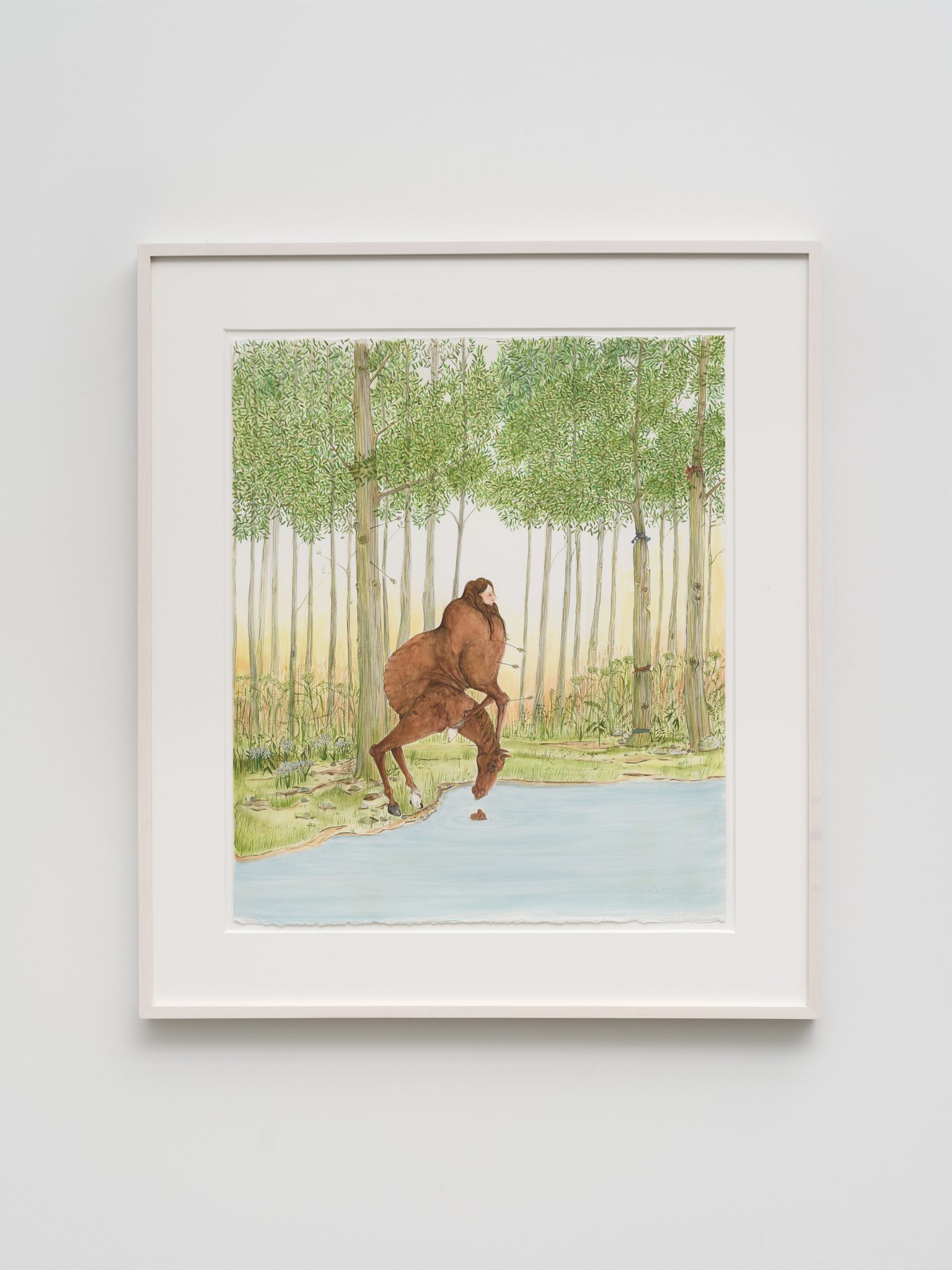
“Narcissus,” 2022
Gouache on paper
22 ³⁄₄" x 19 ¹⁄₄" [HxW] (57.79 x 48.9 cm); 30 ¹⁄₄" x 26 ¹⁄₂" x 1 ¹⁄₂" [HxWxD] (76.83 x 67.31 x 3.81 cm) framed
Inventory #CUT1000
Amy Cutler, courtesy Leslie Tonkonow Artworks + Projects, New York
Photo credit: Jeff McLane
“Narcissus,” 2022
Gouache on paper
22 ³⁄₄" x 19 ¹⁄₄" [HxW] (57.79 x 48.9 cm); 30 ¹⁄₄" x 26 ¹⁄₂" x 1 ¹⁄₂" [HxWxD] (76.83 x 67.31 x 3.81 cm) framed
Inventory #CUT1000
Amy Cutler, courtesy Leslie Tonkonow Artworks + Projects, New York
Photo credit: Jeff McLane
“Narcissus,” 2022
Gouache on paper
22 ³⁄₄" x 19 ¹⁄₄" [HxW] (57.79 x 48.9 cm); 30 ¹⁄₄" x 26 ¹⁄₂" x 1 ¹⁄₂" [HxWxD] (76.83 x 67.31 x 3.81 cm) framed
Inventory #CUT1000
Amy Cutler, courtesy Leslie Tonkonow Artworks + Projects, New York
Photo credit: Jeff McLane
“Narcissus,” 2022
Gouache on paper
22 ³⁄₄" x 19 ¹⁄₄" [HxW] (57.79 x 48.9 cm); 30 ¹⁄₄" x 26 ¹⁄₂" x 1 ¹⁄₂" [HxWxD] (76.83 x 67.31 x 3.81 cm) framed
Inventory #CUT1000
Amy Cutler, courtesy Leslie Tonkonow Artworks + Projects, New York
Photo credit: Jeff McLane
Kim Dingle’s flower paintings are painted on repurposed material, baby blankets specifically, continuing the artist’s practice of using unconventional painting surfaces. As for the subject matter, Dingle says “You sometimes have to paint flowers for your mental health, that’s why you’re doing the flower show right?”.
“Flowers (Yellow),” 2018
Oil on canvas
30" x 30" x 1 ¹⁄₂" [HxWxD] (76.2 x 76.2 x 3.81 cm)
Inventory #DIN240
Courtesy of the artist and Vielmetter Los Angeles
Photo credit: Brica Wilcox
Signed on reverso

“Flowers (Yellow),” 2018
Oil on canvas
30" x 30" x 1 ¹⁄₂" [HxWxD] (76.2 x 76.2 x 3.81 cm)
Inventory #DIN240
Courtesy of the artist and Vielmetter Los Angeles
Photo credit: Brica Wilcox
Signed on reverso
“Flowers (Yellow),” 2018
Oil on canvas
30" x 30" x 1 ¹⁄₂" [HxWxD] (76.2 x 76.2 x 3.81 cm)
Inventory #DIN240
Courtesy of the artist and Vielmetter Los Angeles
Photo credit: Brica Wilcox
Signed on reverso
In recent years, Genevieve Gaignard has incorporated multimedia neon works into her repertoire to visualize electrifying assertions of justice and social reflections. For this exhibition, she created a new neon work on a vintage wallpaper panel that reads “They Love Me, They Love Me Not”. A spinoff of the daisy picking game, it is a powerful response to the Supreme Court’s recent decision to overturn Roe v. Wade.
“Roe v Wade: Liberty and Justice for Some,” 2022
Neon, vintage wallpaper on panel
48" x 36" x 3" [HxWxD] (121.92 x 91.44 x 7.62 cm)
Edition 2 of 4, 2 AP
Inventory #GEN406.02
Courtesy of the artist and Vielmetter Los Angeles
Photo credit: Brica Wilcox
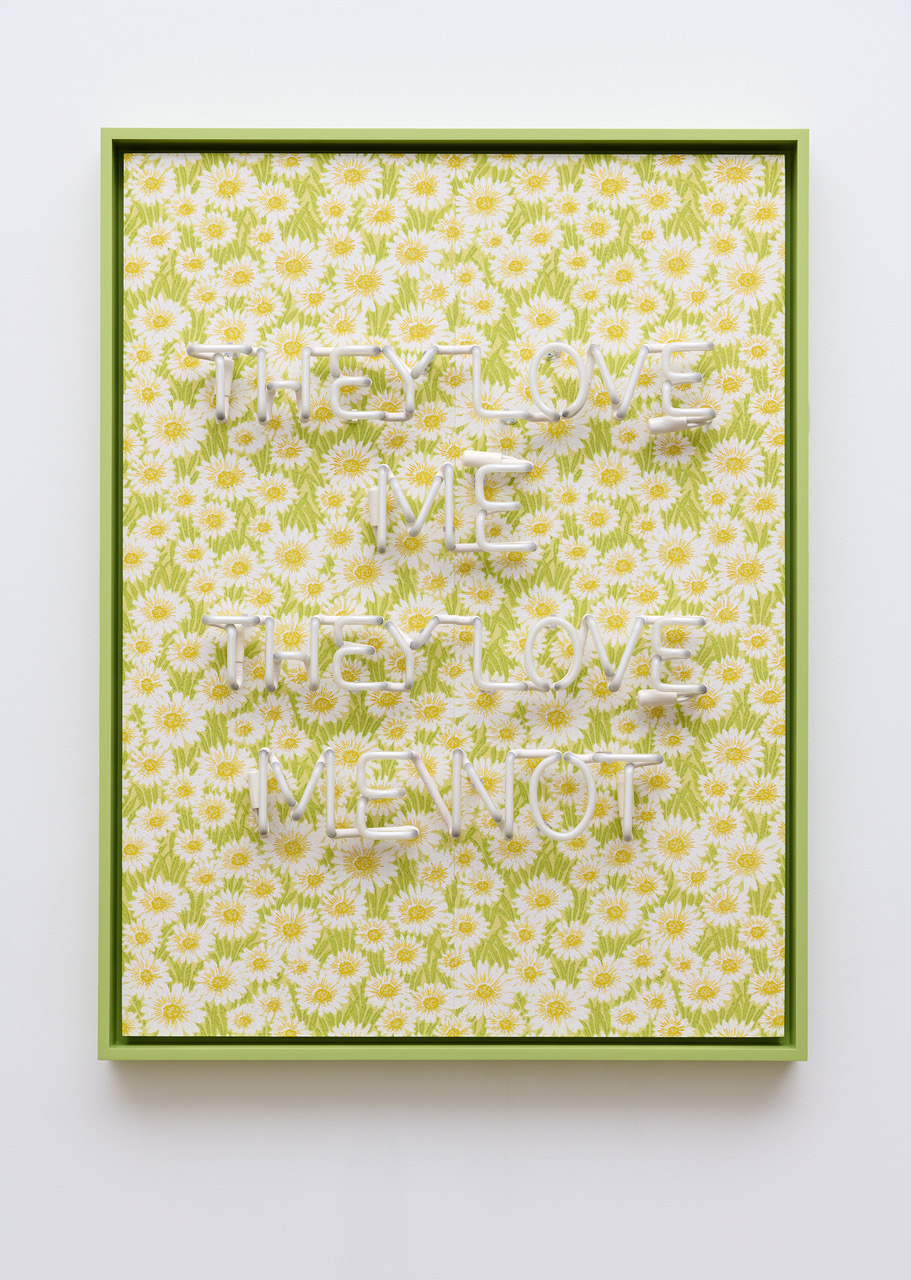
“Roe v Wade: Liberty and Justice for Some,” 2022
Neon, vintage wallpaper on panel
48" x 36" x 3" [HxWxD] (121.92 x 91.44 x 7.62 cm)
Edition 2 of 4, 2 AP
Inventory #GEN406.02
Courtesy of the artist and Vielmetter Los Angeles
Photo credit: Brica Wilcox
“Roe v Wade: Liberty and Justice for Some,” 2022
Neon, vintage wallpaper on panel
48" x 36" x 3" [HxWxD] (121.92 x 91.44 x 7.62 cm)
Edition 2 of 4, 2 AP
Inventory #GEN406.02
Courtesy of the artist and Vielmetter Los Angeles
Photo credit: Brica Wilcox
“Roe v Wade: Liberty and Justice for Some,” 2022
Neon, vintage wallpaper on panel
48" x 36" x 3" [HxWxD] (121.92 x 91.44 x 7.62 cm)
Edition 2 of 4, 2 AP
Inventory #GEN406.02
Courtesy of the artist and Vielmetter Los Angeles
Photo credit: Brica Wilcox
“Roe v Wade: Liberty and Justice for Some,” 2022
Neon, vintage wallpaper on panel
48" x 36" x 3" [HxWxD] (121.92 x 91.44 x 7.62 cm)
Edition 2 of 4, 2 AP
Inventory #GEN406.02
Courtesy of the artist and Vielmetter Los Angeles
Photo credit: Brica Wilcox
“Roe v Wade: Liberty and Justice for Some,” 2022
Neon, vintage wallpaper on panel
48" x 36" x 3" [HxWxD] (121.92 x 91.44 x 7.62 cm)
Edition 2 of 4, 2 AP
Inventory #GEN406.02
Courtesy of the artist and Vielmetter Los Angeles
Photo credit: Brica Wilcox
“Roe v Wade: Liberty and Justice for Some,” 2022
Neon, vintage wallpaper on panel
48" x 36" x 3" [HxWxD] (121.92 x 91.44 x 7.62 cm)
Edition 2 of 4, 2 AP
Inventory #GEN406.02
Courtesy of the artist and Vielmetter Los Angeles
Photo credit: Brica Wilcox
“Roe v Wade: Liberty and Justice for Some,” 2022
Neon, vintage wallpaper on panel
48" x 36" x 3" [HxWxD] (121.92 x 91.44 x 7.62 cm)
Edition 2 of 4, 2 AP
Inventory #GEN406.02
Courtesy of the artist and Vielmetter Los Angeles
Photo credit: Brica Wilcox
“Roe v Wade: Liberty and Justice for Some,” 2022
Neon, vintage wallpaper on panel
48" x 36" x 3" [HxWxD] (121.92 x 91.44 x 7.62 cm)
Edition 2 of 4, 2 AP
Inventory #GEN406.02
Courtesy of the artist and Vielmetter Los Angeles
Photo credit: Brica Wilcox
“Roe v Wade: Liberty and Justice for Some,” 2022
Neon, vintage wallpaper on panel
48" x 36" x 3" [HxWxD] (121.92 x 91.44 x 7.62 cm)
Edition 2 of 4, 2 AP
Inventory #GEN406.02
Courtesy of the artist and Vielmetter Los Angeles
Photo credit: Brica Wilcox
“Roe v Wade: Liberty and Justice for Some,” 2022
Neon, vintage wallpaper on panel
48" x 36" x 3" [HxWxD] (121.92 x 91.44 x 7.62 cm)
Edition 2 of 4, 2 AP
Inventory #GEN406.02
Courtesy of the artist and Vielmetter Los Angeles
Photo credit: Brica Wilcox
In Nash Glynn’s “Yellow Flower” (2021), a soft line moves through the center of the composition to imply a table or floor for a single rose to rest upon. Glynn challenges the gender binary and probes environmental issues by interrogating the idea of nature in both.
“Yellow Flower,” 2021
Acrylic on canvas
30 ¹⁄₄" x 40" x 1 ¹⁄₄" [HxWxD] (76.84 x 101.6 x 3.18 cm)
Inventory #NAS1005
Courtesy of the artist and Vielmetter Los Angeles
Photo credit: Brica Wilcox
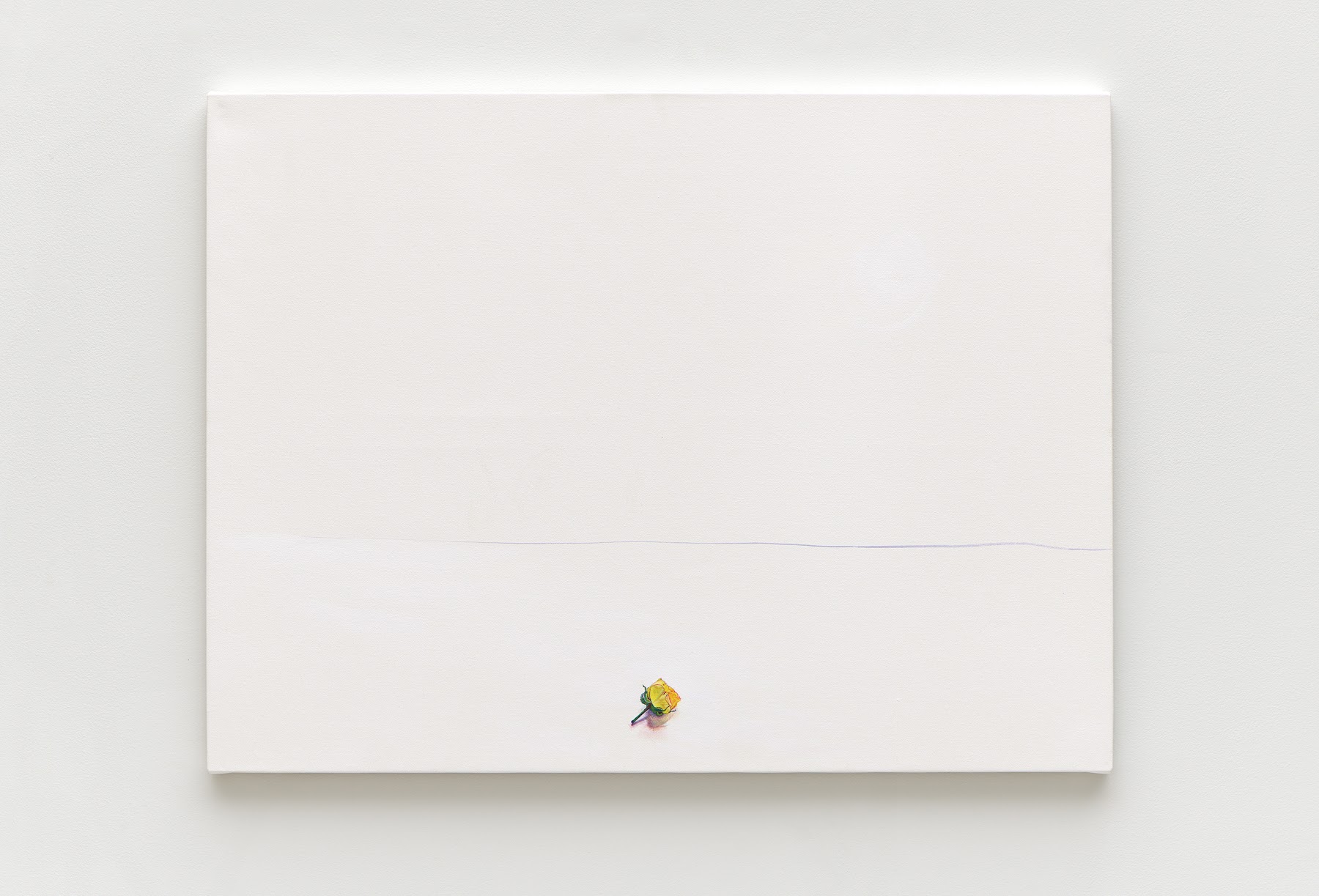
“Yellow Flower,” 2021
Acrylic on canvas
30 ¹⁄₄" x 40" x 1 ¹⁄₄" [HxWxD] (76.84 x 101.6 x 3.18 cm)
Inventory #NAS1005
Courtesy of the artist and Vielmetter Los Angeles
Photo credit: Brica Wilcox
“Yellow Flower,” 2021
Acrylic on canvas
30 ¹⁄₄" x 40" x 1 ¹⁄₄" [HxWxD] (76.84 x 101.6 x 3.18 cm)
Inventory #NAS1005
Courtesy of the artist and Vielmetter Los Angeles
Photo credit: Brica Wilcox
David Horvitz is a conceptual artist with a practice that spans diverse media and subject matter. His work examines questions of the distance between places, people, and time to test the possibilities of appropriating, undermining, or even erasing these distances. For this exhibition, Horvitz presents two installation pieces that follow the movement of oceans, seeds, and flowers as they subtly transgress invisible boundaries. Also, in collaboration with Cassandra Marketos, Horvitz presents a special off-site compost pile located in his urban garden on West Washington Blvd. The compost includes “local ingredients” from the gallery and our neighborhood such as food scraps, coffee grounds, paper, cardboard, palm, grass, weed, and plant clippings, etc.
Cassandra Marketos is a Los Angeles-based compost practitioner and community volunteer. She works in her neighborhood to divert food waste from landfills, build and maintain composts with neighbors, and educate students on decay. She frequently reflects on how rot is essential to life. She went to UC Santa Cruz at some point. She has no formal training in art or artistic practices, of any kind.
“Untitled (Self-Portrait),” 2022
Planter pots filled with an amount of dirt equivalent in weight to the weight of the artist, poppy seeds
Dimensions variable
Inventory #HOR1000
Courtesy of the artist and Vielmetter Los Angeles
Photo credit: Jeff McLane
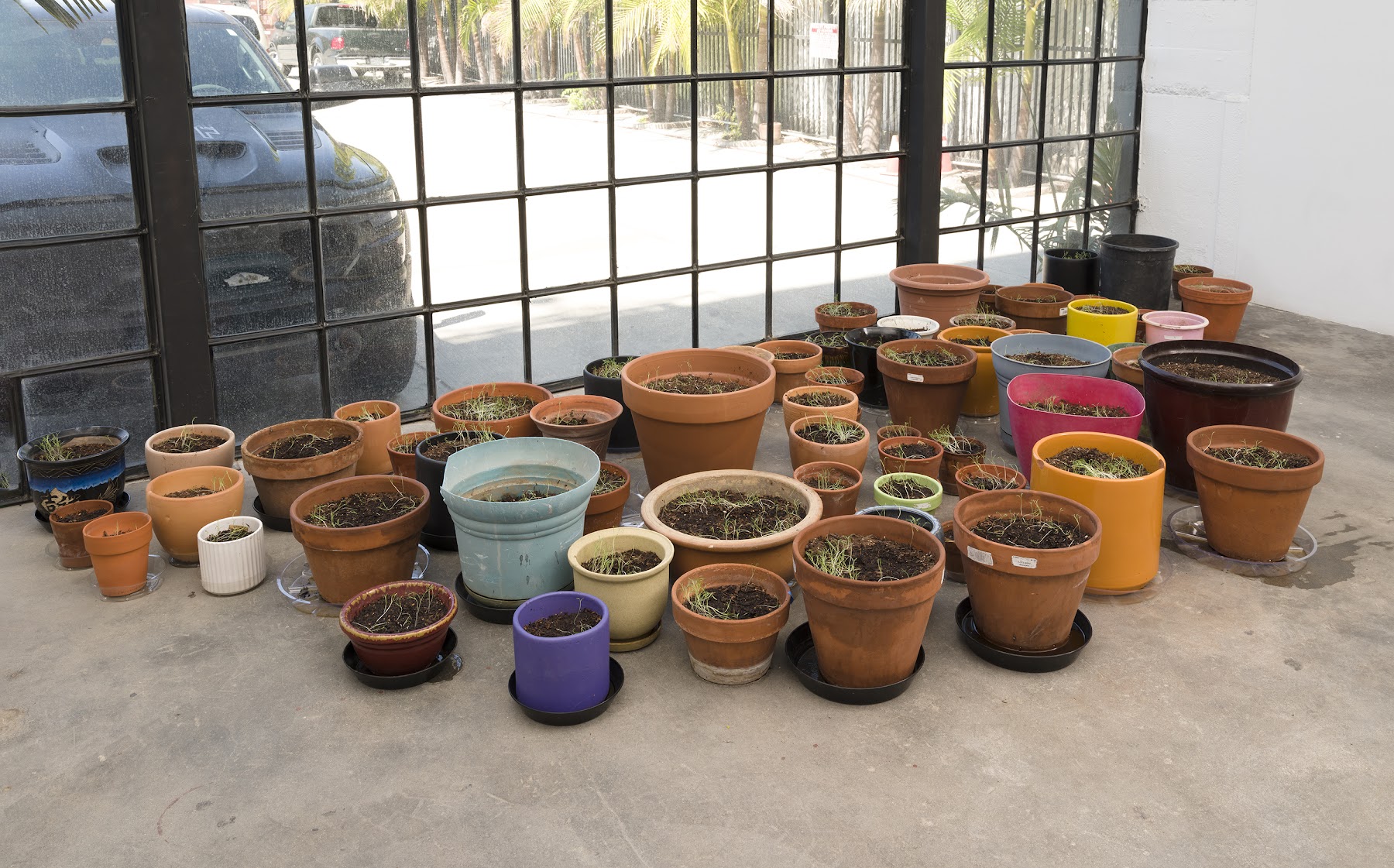
“Untitled (Self-Portrait),” 2022
Planter pots filled with an amount of dirt equivalent in weight to the weight of the artist, poppy seeds
Dimensions variable
Inventory #HOR1000
Courtesy of the artist and Vielmetter Los Angeles
Photo credit: Jeff McLane
Raffi Kalenderian’s painting continues the artist’s “psychedelic jungle” series. The portrait of a female figure against a sunset is framed by bright tropical plants adding a vibrant and hot-hued atmosphere to the painting.
“Isis,” 2022
Oil on linen
72" x 62" [HxW] (182.88 x 157.48 cm)
Inventory #KAL304
Courtesy of the artist and Vielmetter Los Angeles
Photo credit: Jeff McLane

“Isis,” 2022
Oil on linen
72" x 62" [HxW] (182.88 x 157.48 cm)
Inventory #KAL304
Courtesy of the artist and Vielmetter Los Angeles
Photo credit: Jeff McLane
“Isis,” 2022
Oil on linen
72" x 62" [HxW] (182.88 x 157.48 cm)
Inventory #KAL304
Courtesy of the artist and Vielmetter Los Angeles
Photo credit: Jeff McLane
“Isis,” 2022
Oil on linen
72" x 62" [HxW] (182.88 x 157.48 cm)
Inventory #KAL304
Courtesy of the artist and Vielmetter Los Angeles
Photo credit: Jeff McLane
“Isis,” 2022
Oil on linen
72" x 62" [HxW] (182.88 x 157.48 cm)
Inventory #KAL304
Courtesy of the artist and Vielmetter Los Angeles
Photo credit: Jeff McLane
“Isis,” 2022
Oil on linen
72" x 62" [HxW] (182.88 x 157.48 cm)
Inventory #KAL304
Courtesy of the artist and Vielmetter Los Angeles
Photo credit: Jeff McLane
Is framing the bag and hanging on the wall reusing or recycling?, 2022 is part of a new series of watercolor, acrylic paint, and ink on paper by New York-based artist, Joan Linder, that takes a close look at packaging and paperwork. Double-sided, sometimes folded, sometimes flat, these works on paper are life-size, a faithful recreation of everyday recyclable objects, in this case, the iconic Trader Joe’s shopping bag. The ubiquitous Trader Joe’s bag begs the question – is it art or recycling, or in this case is it bespoke recycling?
“Is framing the bag and hanging it on the wall reusing or recycling?,” 2022
Ink on paper
21 ¹⁄₄" x 38 ¹⁄₄" [HxW] (53.98 x 97.16 cm)
Inventory #LIN1000
Courtesy of the artist and Cristin Tierney Gallery
Photo credit: Brica Wilcox
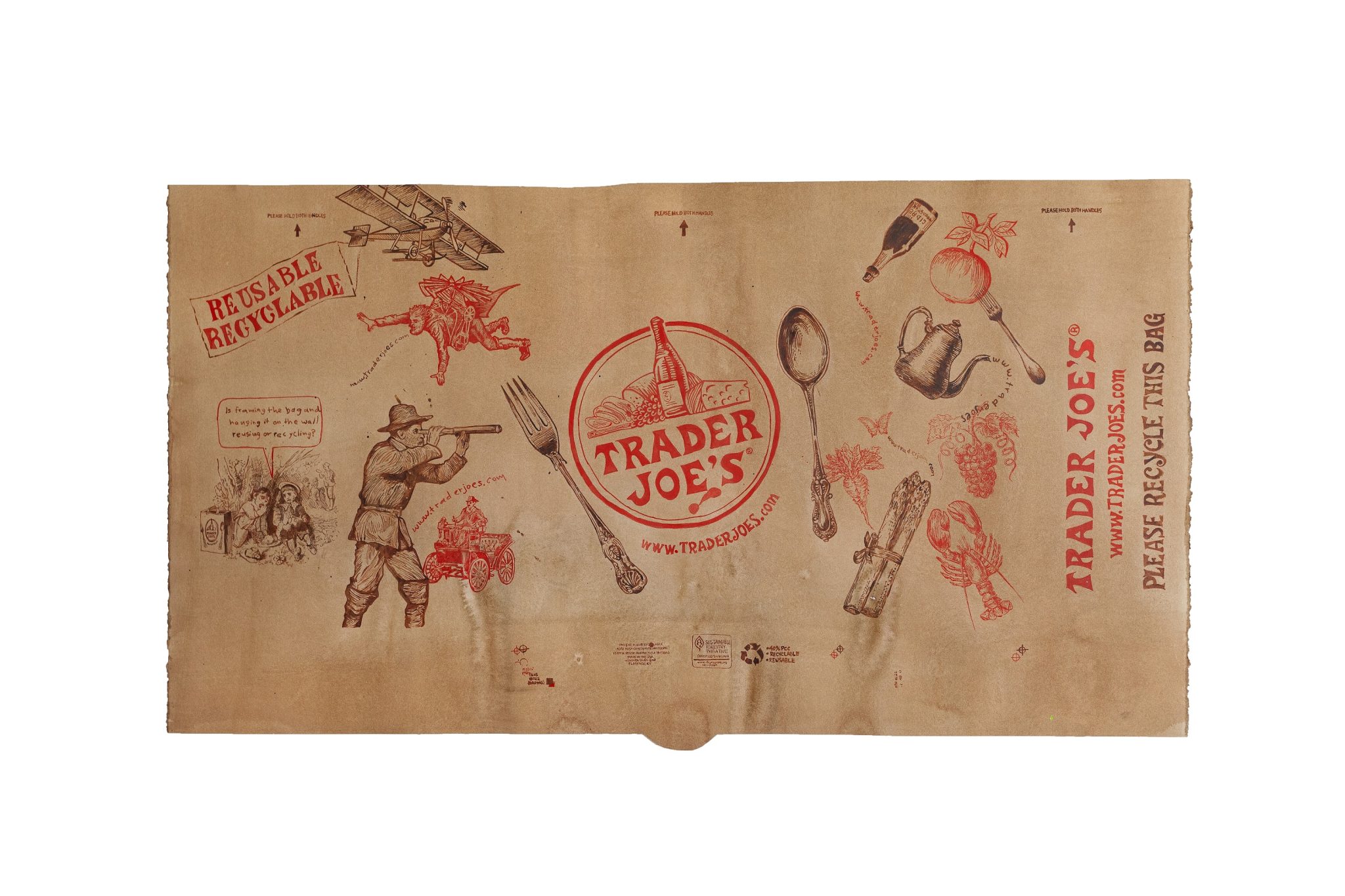
“Is framing the bag and hanging it on the wall reusing or recycling?,” 2022
Ink on paper
21 ¹⁄₄" x 38 ¹⁄₄" [HxW] (53.98 x 97.16 cm)
Inventory #LIN1000
Courtesy of the artist and Cristin Tierney Gallery
Photo credit: Brica Wilcox
In a book by feminist scientist Hope Jahren, Jenny Kendler discovered that the scaffold of Hackberry (Celtis occidentalis) seeds is composed of Si02.nH20 or amorphous hydrated silicon oxide—technically the precious gemstone opal. This sculpture takes the form of an heirloom necklace, but with Hackberry seeds where one might normally expect costly gems, provoking the question: What heirlooms will we leave for future generations?
“Heirloom (Hackberry Opal Necklace for Hope Jahren),” 2022
Hackberry seeds (Celtis occidentalis), silk string, and vintage clasp in artist’s frame
22" x 22" x 3 ³⁄₄" [HxWxD] (55.88 x 55.88 x 9.53 cm)
Inventory #KEN1000
Courtesy of the artist
Photo credit: Brica Wilcox
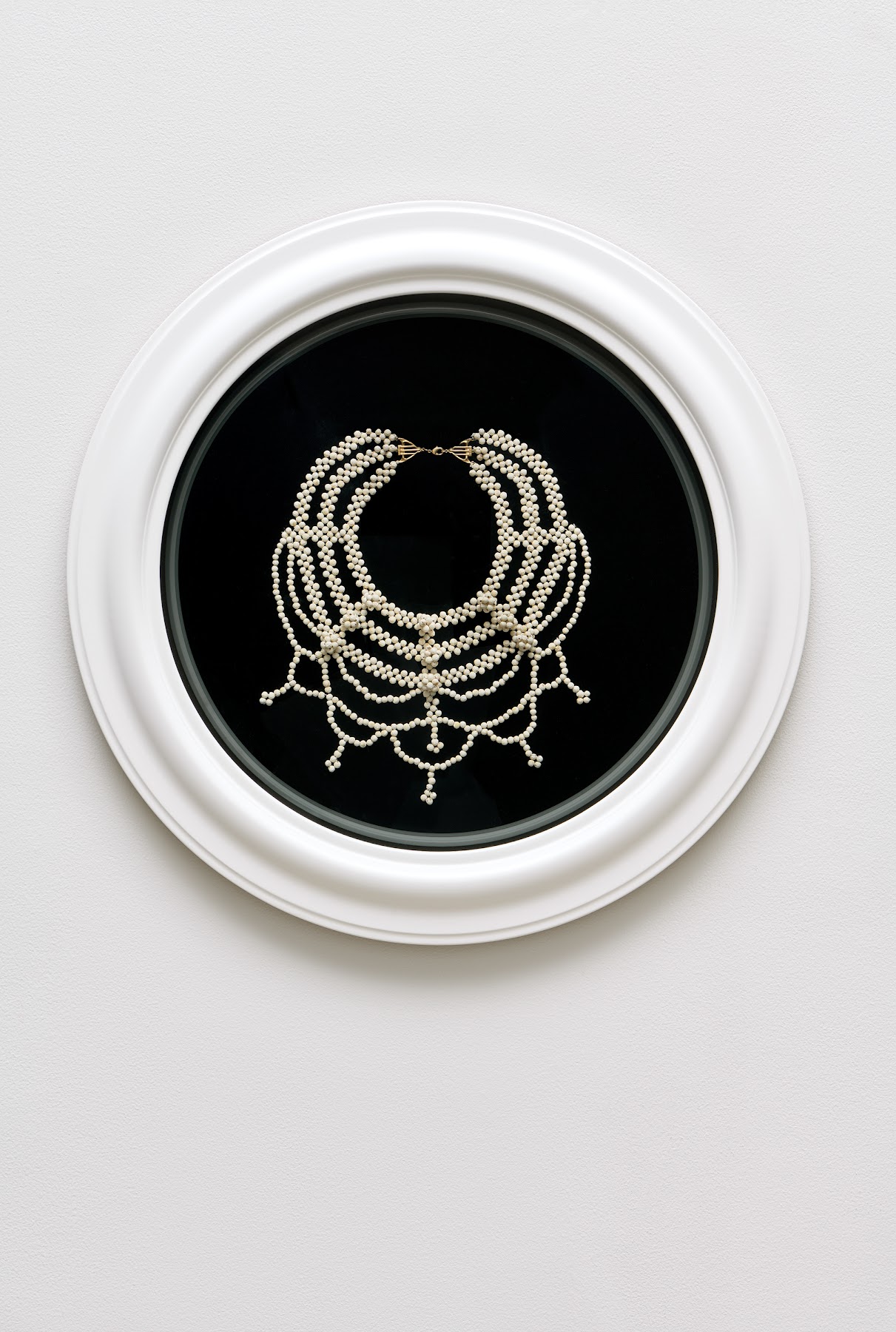
“Heirloom (Hackberry Opal Necklace for Hope Jahren),” 2022
Hackberry seeds (Celtis occidentalis), silk string, and vintage clasp in artist’s frame
22" x 22" x 3 ³⁄₄" [HxWxD] (55.88 x 55.88 x 9.53 cm)
Inventory #KEN1000
Courtesy of the artist
Photo credit: Brica Wilcox
“Heirloom (Hackberry Opal Necklace for Hope Jahren),” 2022
Hackberry seeds (Celtis occidentalis), silk string, and vintage clasp in artist’s frame
22" x 22" x 3 ³⁄₄" [HxWxD] (55.88 x 55.88 x 9.53 cm)
Inventory #KEN1000
Courtesy of the artist
Photo credit: Brica Wilcox
Hugo McCloud’s paintings exhibit skillful expertise in manipulating single-use plastic bags to transform them into texturally rich swaths of color, creating complex and visually stunning forms. His newest still life continues McCloud’s strategy to maintain calm and focus during the pandemic, offering the viewer a moment of respite and an invitation to slow down.
“Hidden shadows,” 2022
Plastic merchandise bags on wood panel
67 ³⁄₄" x 33 ³⁄₄" Framed [HxW] (172.08 x 85.72 cm)
Inventory #MCC174
Courtesy of the artist and Vielmetter Los Angeles
Photo credit: Jeff McLane
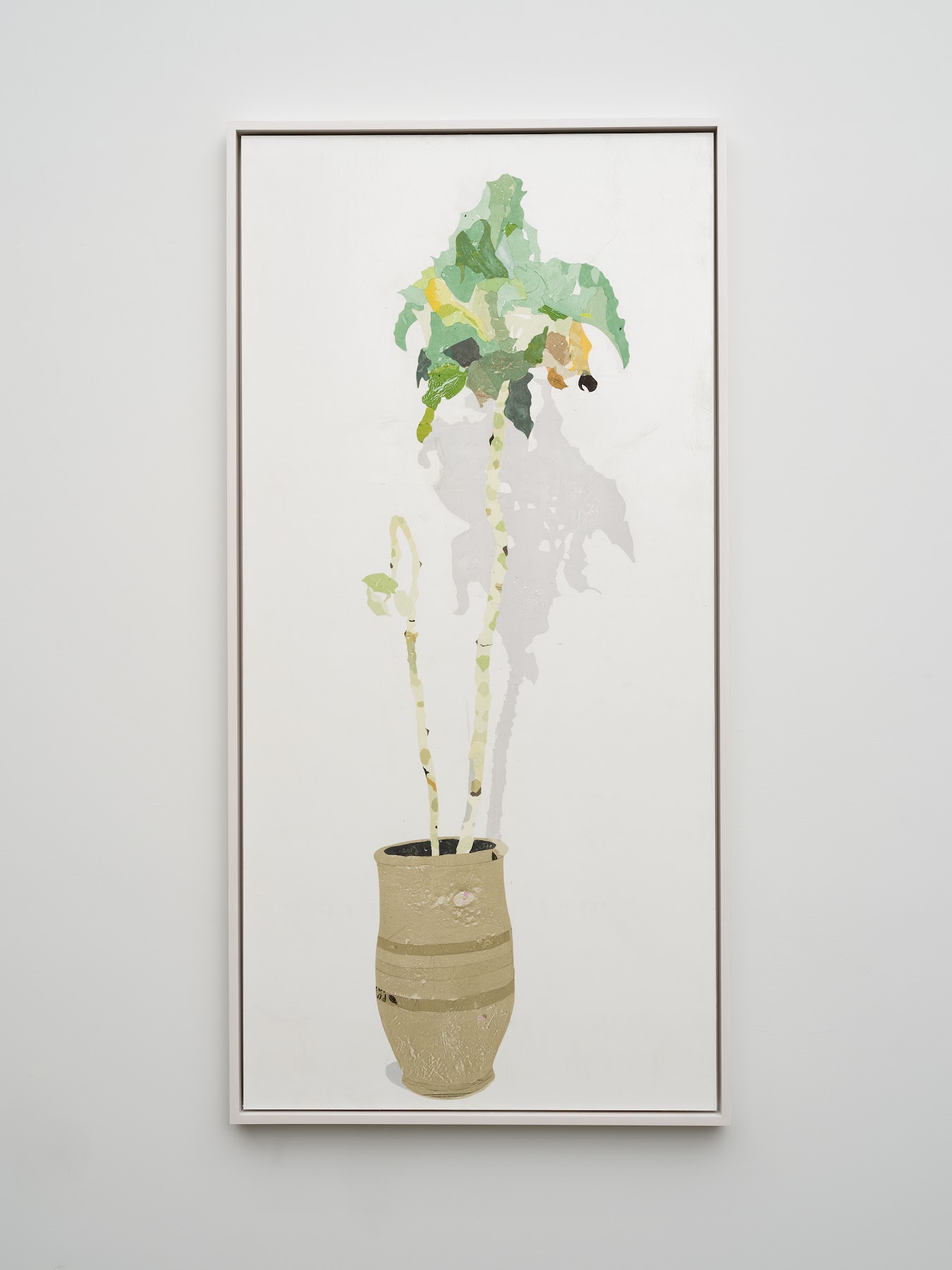
“Hidden shadows,” 2022
Plastic merchandise bags on wood panel
67 ³⁄₄" x 33 ³⁄₄" Framed [HxW] (172.08 x 85.72 cm)
Inventory #MCC174
Courtesy of the artist and Vielmetter Los Angeles
Photo credit: Jeff McLane
“Hidden shadows,” 2022
Plastic merchandise bags on wood panel
67 ³⁄₄" x 33 ³⁄₄" Framed [HxW] (172.08 x 85.72 cm)
Inventory #MCC174
Courtesy of the artist and Vielmetter Los Angeles
Photo credit: Jeff McLane
“Hidden shadows,” 2022
Plastic merchandise bags on wood panel
67 ³⁄₄" x 33 ³⁄₄" Framed [HxW] (172.08 x 85.72 cm)
Inventory #MCC174
Courtesy of the artist and Vielmetter Los Angeles
Photo credit: Jeff McLane
Rodney McMillian’s new still life painting features empty vases, harkening back to his 2016 exhibition Chisholm’s Reverb, which featured a large installation of thrift store vases, spray-painted black, carefully positioned on shelves surrounding a large sculpture and receiving an audio installation that combined a speech by Shirley Chisholm with Alice Coltrane’s “Journey to Satchidananda.” Historically, still-life paintings have served as allegorical representations of the mundane and repetitive aspects of human life; particularly those related to the consumption of food and intoxicants, knowledge, and beauty. While McMillian’s still lifes may point to an ordinariness of beauty, they are also vessels that once held flowers but now hold sounds.
Early in Summer 2022, Paul Mpagi Sepuya was a resident at the Anderson Ranch Arts Center where he spent time working with historical photo printing methods. This new series of unique salt prints document California Native plants in the artist’s garden.
“Garden (IMG_4713),” 2022
Salted paper print
13 ³⁄₄" x 10 ³⁄₄" [HxW] (34.93 x 27.31 cm); 16 ¹⁄₄" x 13 ¹⁄₂" x 1 ¹⁄₂" [HxWxD] (41.27 x 34.29 x 3.81 cm)
Inventory #SEP754
Courtesy of the artist and Vielmetter Los Angeles
Photo credit: Brica Wilcox

“Garden (IMG_4713),” 2022
Salted paper print
13 ³⁄₄" x 10 ³⁄₄" [HxW] (34.93 x 27.31 cm); 16 ¹⁄₄" x 13 ¹⁄₂" x 1 ¹⁄₂" [HxWxD] (41.27 x 34.29 x 3.81 cm)
Inventory #SEP754
Courtesy of the artist and Vielmetter Los Angeles
Photo credit: Brica Wilcox
Artist and mycologist Sam Shoemaker’s ceramic sculptures act as vessels for fungal growth, their interior cavities inoculated with strains of reishi mushrooms that protrude outward to form striking and unpredictable fruiting bodies. After studying sculpture, Shoemaker created Myco Myco, a studio, and laboratory dedicated to mushroom cultivation, citizen science, and experimental mycology, and has since led numerous mushroom cultivation workshops across Southern California.
“Vessel #XI,” 2021
Ceramic, Ganoderma lingzhi (reishi mushroom), supplemented sawdust
17" x 9" x 17" [HxWxD] (43.18 x 22.86 x 43.18 cm)
Inventory #SAM1001
Courtesy of the artist and Vielmetter Los Angeles
Photo credit: Jeff McLane

“Vessel #XI,” 2021
Ceramic, Ganoderma lingzhi (reishi mushroom), supplemented sawdust
17" x 9" x 17" [HxWxD] (43.18 x 22.86 x 43.18 cm)
Inventory #SAM1001
Courtesy of the artist and Vielmetter Los Angeles
Photo credit: Jeff McLane
“Vessel #XI,” 2021
Ceramic, Ganoderma lingzhi (reishi mushroom), supplemented sawdust
17" x 9" x 17" [HxWxD] (43.18 x 22.86 x 43.18 cm)
Inventory #SAM1001
Courtesy of the artist and Vielmetter Los Angeles
Photo credit: Jeff McLane
“Vessel #XI,” 2021
Ceramic, Ganoderma lingzhi (reishi mushroom), supplemented sawdust
17" x 9" x 17" [HxWxD] (43.18 x 22.86 x 43.18 cm)
Inventory #SAM1001
Courtesy of the artist and Vielmetter Los Angeles
Photo credit: Jeff McLane
Working in the realm of figurative sculpture, Jessica Stoller (b. 1981) mines the rich and complicated history of porcelain, harnessing its links to power, desire, and taste. Synthesizing the cultural, historical, and corporeal notions of the female body, Stoller expands the feminist visual vernacular and makes space for subversion, defiance, and play. For Stoller the ‘grotesque’ becomes a powerful tool to challenge patriarchal power structures, as female figures flaunt what they are told to hide, reveling in their own pleasure and abjection.
“Untitled (close up #3),” 2020
Porcelain, glaze, china paint, lustre, wood
19" x 15" x 2" [HxWxD] (48.26 x 38.1 x 5.08 cm)
Inventory #STO1000
Courtesy of Jessica Stoller; Vielmetter Los Angeles; and P·P·O·W, New York
Photo credit: Brica Wilcox

“Untitled (close up #3),” 2020
Porcelain, glaze, china paint, lustre, wood
19" x 15" x 2" [HxWxD] (48.26 x 38.1 x 5.08 cm)
Inventory #STO1000
Courtesy of Jessica Stoller; Vielmetter Los Angeles; and P·P·O·W, New York
Photo credit: Brica Wilcox
“Untitled (close up #3),” 2020
Porcelain, glaze, china paint, lustre, wood
19" x 15" x 2" [HxWxD] (48.26 x 38.1 x 5.08 cm)
Inventory #STO1000
Courtesy of Jessica Stoller; Vielmetter Los Angeles; and P·P·O·W, New York
Photo credit: Brica Wilcox
Nicola Tyson’s drawings of anthropomorphic flowers and weeds have a humoristic quality. Living in upstate New York, Tyson has long been inspired by nature and the characteristics of the flora and fauna in her environment.
“Buds,” 2020
Graphite on paper
9 ¹⁄₄" x 7" [HxW] (23.5 x 17.78 cm); 16" x 13 ¹⁄₂" x 1 ¹⁄₂" [HxWxD] (40.64 x 34.29 x 3.81 cm) Framed
Inventory #TYS241
Courtesy of the artist and Vielmetter Los Angeles
Photo credit: Jeff McLane

“Buds,” 2020
Graphite on paper
9 ¹⁄₄" x 7" [HxW] (23.5 x 17.78 cm); 16" x 13 ¹⁄₂" x 1 ¹⁄₂" [HxWxD] (40.64 x 34.29 x 3.81 cm) Framed
Inventory #TYS241
Courtesy of the artist and Vielmetter Los Angeles
Photo credit: Jeff McLane
Ariane Vielmetter uses the conventions of still life and trompe l’oeil painting as a way to convey both plausible fictions and uncanny truths. She draws from a variety of source materials, ranging from repurposed studio scraps and unfinished drawings to specimens collected from her compost pile and garden, medical illustrations, and works by artists and writers who have been historically overlooked.
“Taproot,” 2016
Gesso and watercolor on newsprint
70 ¹⁄₂" x 18" [HxW] (179.07 x 45.72 cm)
Inventory #AV1003
Courtesy of the artist and Vielmetter Los Angeles

“Taproot,” 2016
Gesso and watercolor on newsprint
70 ¹⁄₂" x 18" [HxW] (179.07 x 45.72 cm)
Inventory #AV1003
Courtesy of the artist and Vielmetter Los Angeles
“Taproot,” 2016
Gesso and watercolor on newsprint
70 ¹⁄₂" x 18" [HxW] (179.07 x 45.72 cm)
Inventory #AV1003
Courtesy of the artist and Vielmetter Los Angeles
“Taproot,” 2016
Gesso and watercolor on newsprint
70 ¹⁄₂" x 18" [HxW] (179.07 x 45.72 cm)
Inventory #AV1003
Courtesy of the artist and Vielmetter Los Angeles
Tam Van Tran has recently focused on making ceramic vessels that depict a rich tapestry of plant and sea life. In this new vessel that he created for the show, imaginary animals are making offerings with flowers in their mouths.
“Wind Horse,” 2022
Glazed stoneware
24" x 22" x 21" [HxWxD] (60.96 x 55.88 x 53.34 cm)
Inventory #TRA359
Courtesy of the artist and Vielmetter Los Angeles
Photo credit: Jeff McLane

“Wind Horse,” 2022
Glazed stoneware
24" x 22" x 21" [HxWxD] (60.96 x 55.88 x 53.34 cm)
Inventory #TRA359
Courtesy of the artist and Vielmetter Los Angeles
Photo credit: Jeff McLane
“Wind Horse,” 2022
Glazed stoneware
24" x 22" x 21" [HxWxD] (60.96 x 55.88 x 53.34 cm)
Inventory #TRA359
Courtesy of the artist and Vielmetter Los Angeles
Photo credit: Jeff McLane
“Wind Horse,” 2022
Glazed stoneware
24" x 22" x 21" [HxWxD] (60.96 x 55.88 x 53.34 cm)
Inventory #TRA359
Courtesy of the artist and Vielmetter Los Angeles
Photo credit: Jeff McLane
“Wind Horse,” 2022
Glazed stoneware
24" x 22" x 21" [HxWxD] (60.96 x 55.88 x 53.34 cm)
Inventory #TRA359
Courtesy of the artist and Vielmetter Los Angeles
Photo credit: Jeff McLane
“Wind Horse,” 2022
Glazed stoneware
24" x 22" x 21" [HxWxD] (60.96 x 55.88 x 53.34 cm)
Inventory #TRA359
Courtesy of the artist and Vielmetter Los Angeles
Photo credit: Jeff McLane
“Wind Horse,” 2022
Glazed stoneware
24" x 22" x 21" [HxWxD] (60.96 x 55.88 x 53.34 cm)
Inventory #TRA359
Courtesy of the artist and Vielmetter Los Angeles
Photo credit: Jeff McLane
Shanna Waddell’s paintings of floral still lives dwell in the realm of her fictional artist-run commune s/henesss society. The flowers depicted come from the s/heness society’s communal flower farm and exude the society’s utopian values of sustainability and collectivity.
“s/heness society floral still life,” 2021
Oil on canvas
18 ³⁄₄" x 16 ¹⁄₂" x ³⁄₄" [HxWxD] (47.63 x 41.91 x 1.91 cm)
Inventory #WAD1000
Courtesy of the artist and Vielmetter Los Angeles
Photo credit: Brica Wilcox

“s/heness society floral still life,” 2021
Oil on canvas
18 ³⁄₄" x 16 ¹⁄₂" x ³⁄₄" [HxWxD] (47.63 x 41.91 x 1.91 cm)
Inventory #WAD1000
Courtesy of the artist and Vielmetter Los Angeles
Photo credit: Brica Wilcox
“s/heness society floral still life,” 2022
Oil on canvas
53" x 42 ¹⁄₂" x 1 ¹⁄₂" [HxWxD] (134.62 x 107.95 x 3.81 cm)
Inventory #WAD1002
Courtesy of the artist and Vielmetter Los Angeles
Photo credit: Brica Wilcox

“s/heness society floral still life,” 2022
Oil on canvas
53" x 42 ¹⁄₂" x 1 ¹⁄₂" [HxWxD] (134.62 x 107.95 x 3.81 cm)
Inventory #WAD1002
Courtesy of the artist and Vielmetter Los Angeles
Photo credit: Brica Wilcox
“s/heness society floral still life,” 2022
Oil on canvas
53" x 42 ¹⁄₂" x 1 ¹⁄₂" [HxWxD] (134.62 x 107.95 x 3.81 cm)
Inventory #WAD1002
Courtesy of the artist and Vielmetter Los Angeles
Photo credit: Brica Wilcox
“s/heness society floral still life,” 2022
Oil on canvas
53" x 42 ¹⁄₂" x 1 ¹⁄₂" [HxWxD] (134.62 x 107.95 x 3.81 cm)
Inventory #WAD1002
Courtesy of the artist and Vielmetter Los Angeles
Photo credit: Brica Wilcox
Esther Pearl Watson and Mark Todd have collaborated on a sequined hot pink sculpture of a flower cart for the exhibition made with repurposed materials. Often working together to create three-dimensional work, Esther and Mark’s sculptures exude playful energy akin to their unique practices in zine-making and world-building.
“Flip Flop,” 2022
Mixed media
106" x 67" x 27" [HxWxD] (269.24 x 170.18 x 68.58 cm)
Inventory #EPW443
Courtesy of the artist and Vielmetter Los Angeles
Photo credit: Jeff McLane

“Flip Flop,” 2022
Mixed media
106" x 67" x 27" [HxWxD] (269.24 x 170.18 x 68.58 cm)
Inventory #EPW443
Courtesy of the artist and Vielmetter Los Angeles
Photo credit: Jeff McLane
“Flip Flop,” 2022
Mixed media
106" x 67" x 27" [HxWxD] (269.24 x 170.18 x 68.58 cm)
Inventory #EPW443
Courtesy of the artist and Vielmetter Los Angeles
Photo credit: Jeff McLane
“Flip Flop,” 2022
Mixed media
106" x 67" x 27" [HxWxD] (269.24 x 170.18 x 68.58 cm)
Inventory #EPW443
Courtesy of the artist and Vielmetter Los Angeles
Photo credit: Jeff McLane
“Flip Flop,” 2022
Mixed media
106" x 67" x 27" [HxWxD] (269.24 x 170.18 x 68.58 cm)
Inventory #EPW443
Courtesy of the artist and Vielmetter Los Angeles
Photo credit: Jeff McLane
“Flip Flop,” 2022
Mixed media
106" x 67" x 27" [HxWxD] (269.24 x 170.18 x 68.58 cm)
Inventory #EPW443
Courtesy of the artist and Vielmetter Los Angeles
Photo credit: Jeff McLane
“Flip Flop,” 2022
Mixed media
106" x 67" x 27" [HxWxD] (269.24 x 170.18 x 68.58 cm)
Inventory #EPW443
Courtesy of the artist and Vielmetter Los Angeles
Photo credit: Jeff McLane
Patrick Wilson is a West Coast minimalist painter in lineage with the evolving history of the California Light and Space movement. His hard-edged paintings of varying planes and opacities are composed of fastidiously applied layers of acrylic paint; creating super-flat surfaces of varying colors which are often derived from the light, the atmosphere, and the nature of Southern California.
“March Madness,” 2022
Acrylic on canvas
30" x 72" [HxW] (76.2 x 182.88 cm)
Inventory #WIL601
Courtesy of the artist and Vielmetter Los Angeles
Photo credit: Jeff McLane

“March Madness,” 2022
Acrylic on canvas
30" x 72" [HxW] (76.2 x 182.88 cm)
Inventory #WIL601
Courtesy of the artist and Vielmetter Los Angeles
Photo credit: Jeff McLane
Covered in sgraffito drawings based on archival Soviet-era textile designs, Bari Ziperstein’s “Flowers for the People” (2020) engages with ideas of consumerism, propaganda, and the built environment through her continued exploration of ceramic forms.
“Flowers for the People,” 2020
Stoneware and glaze
32" x 24 ³⁄₄" [HxW] (81.28 x 62.87 cm)
Inventory #ZIP1011
Courtesy of the artist and Vielmetter Los Angeles
Photo credit: Jeff McLane

“Flowers for the People,” 2020
Stoneware and glaze
32" x 24 ³⁄₄" [HxW] (81.28 x 62.87 cm)
Inventory #ZIP1011
Courtesy of the artist and Vielmetter Los Angeles
Photo credit: Jeff McLane













